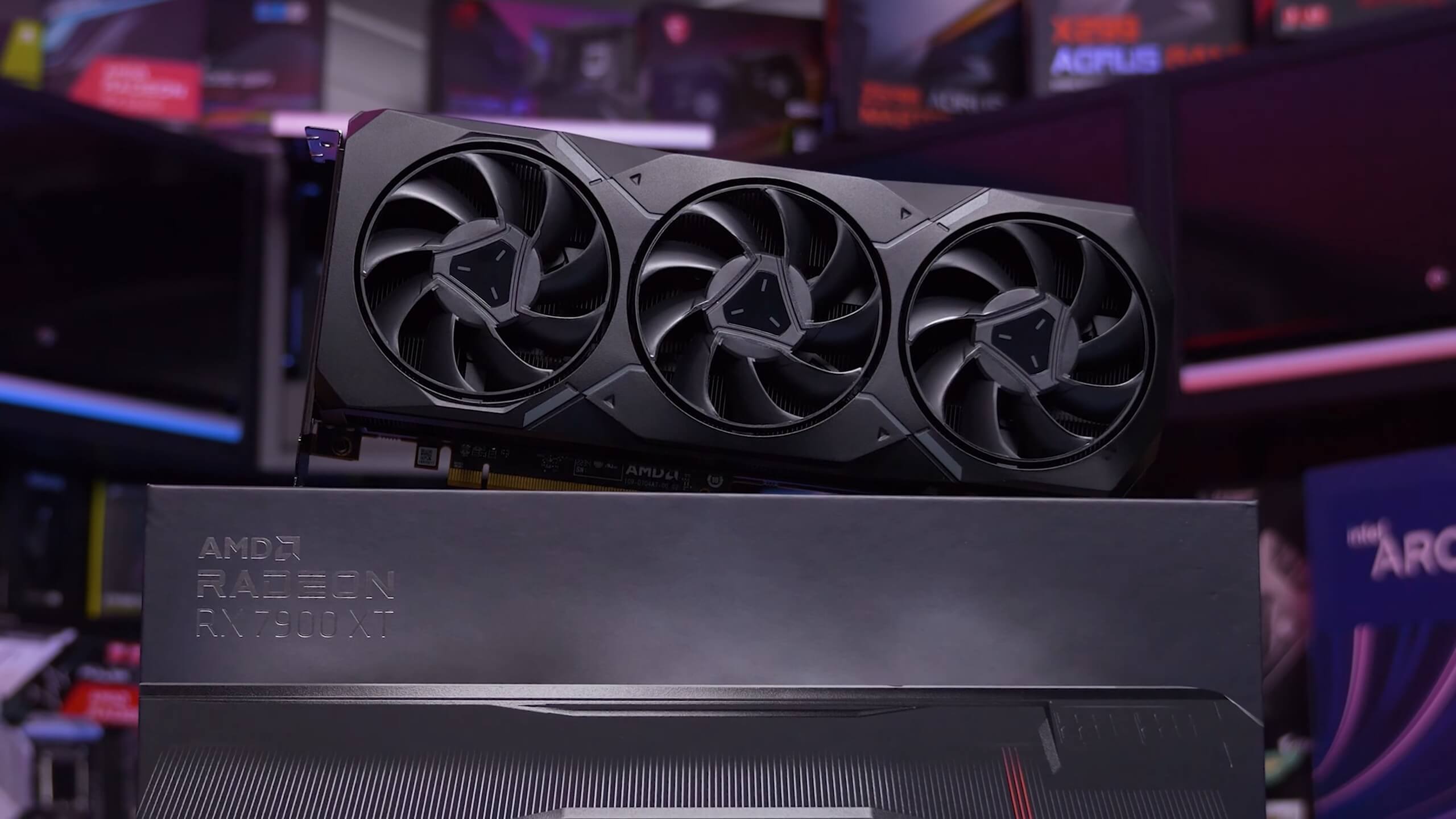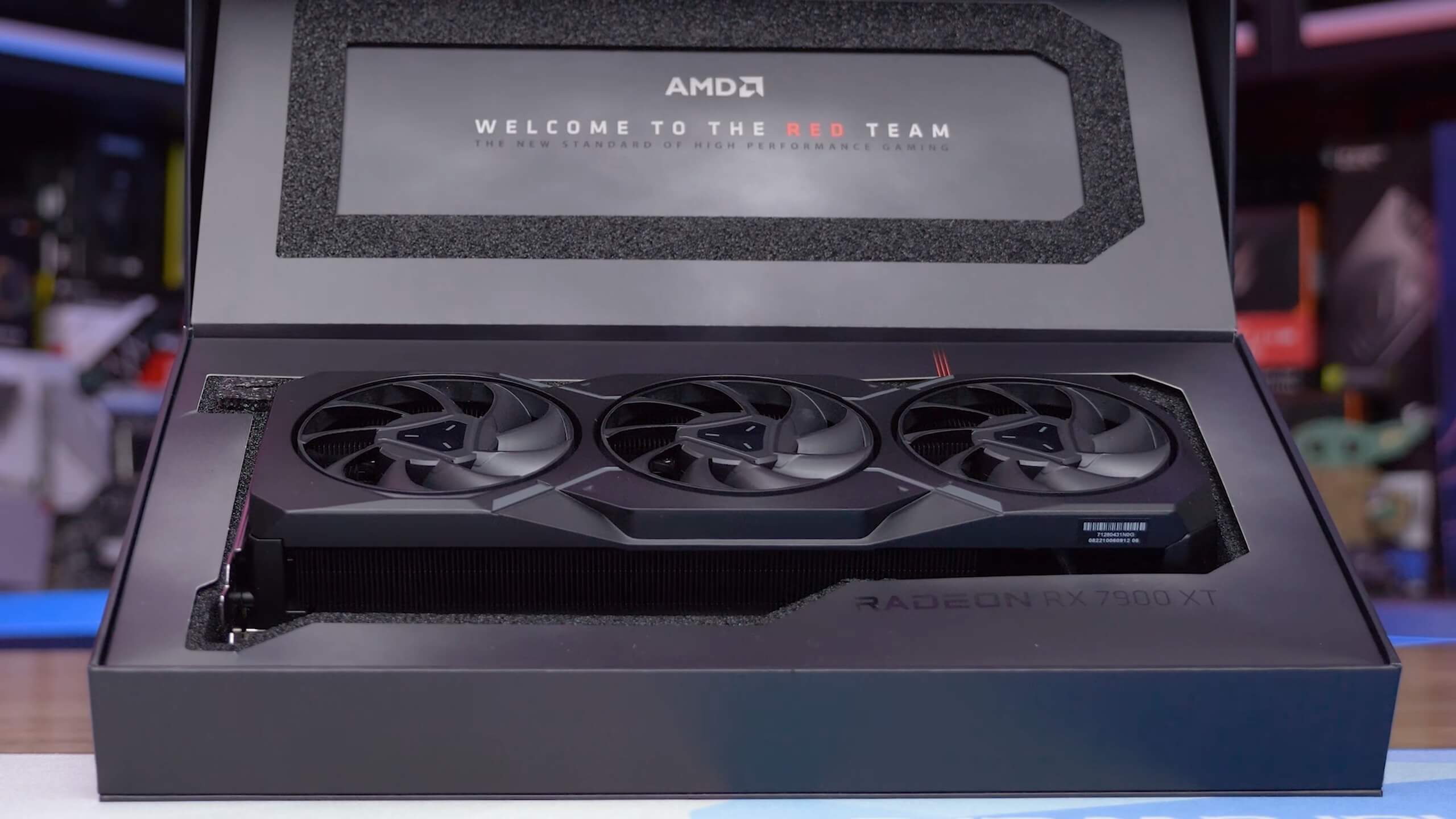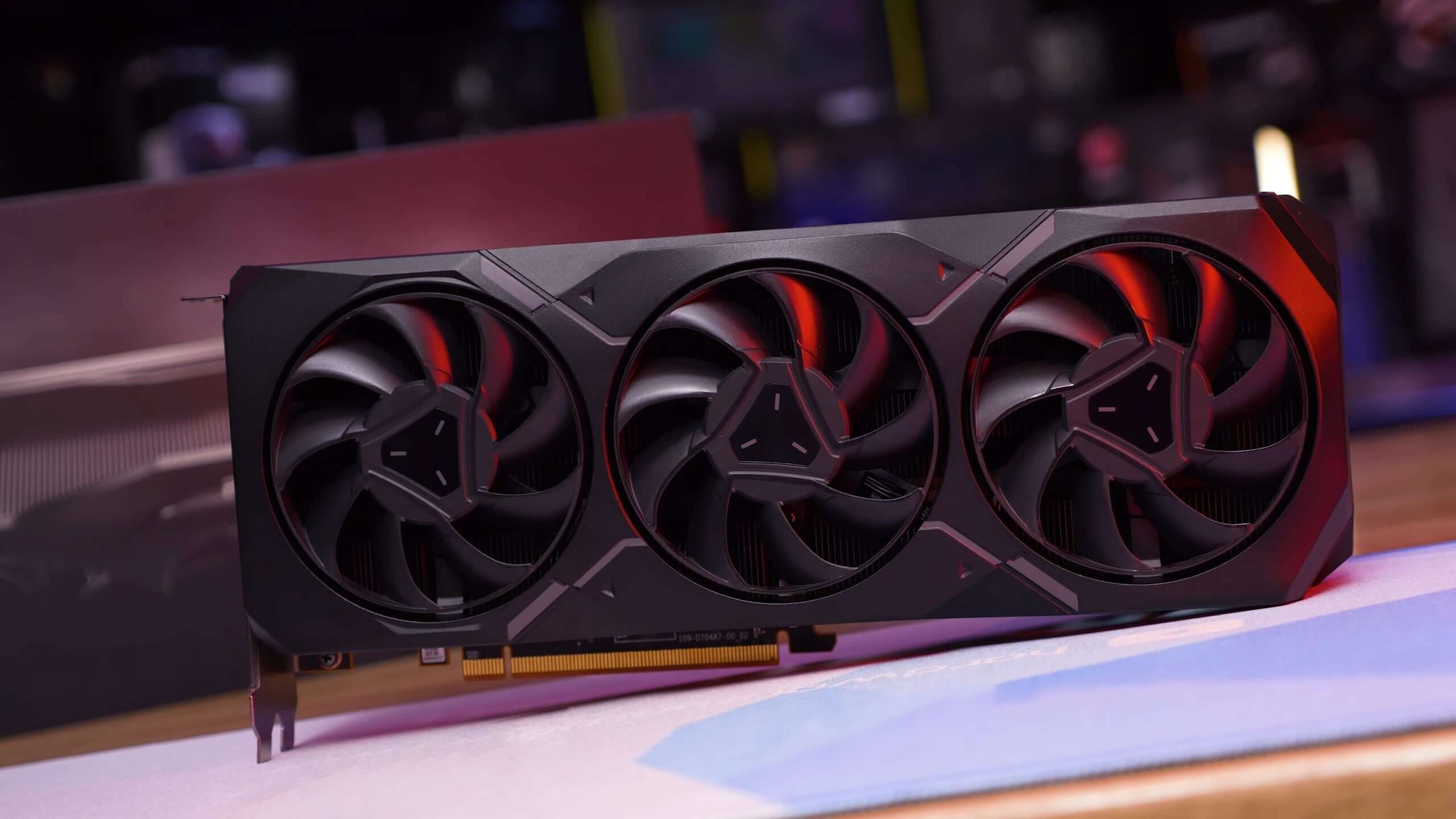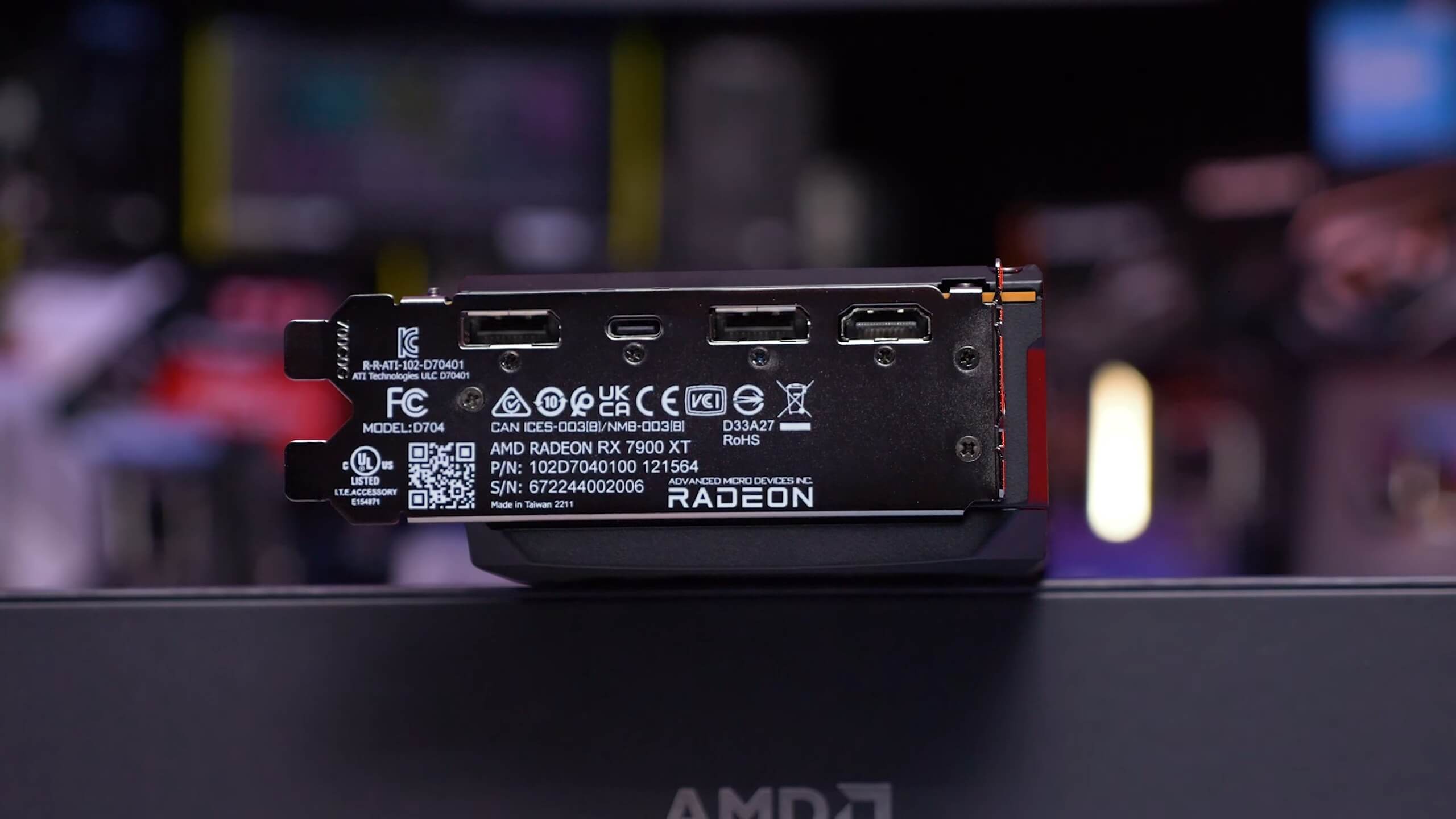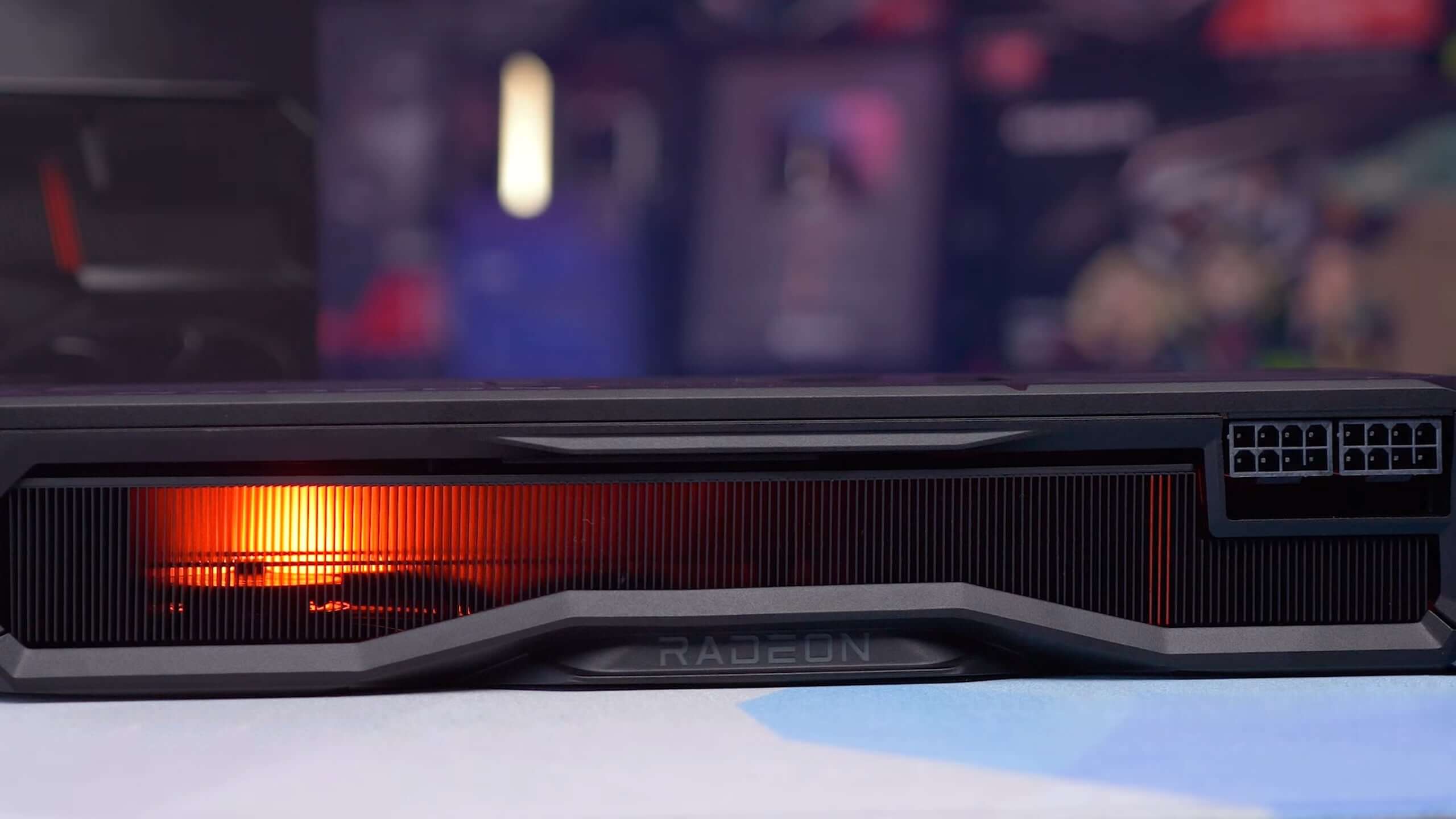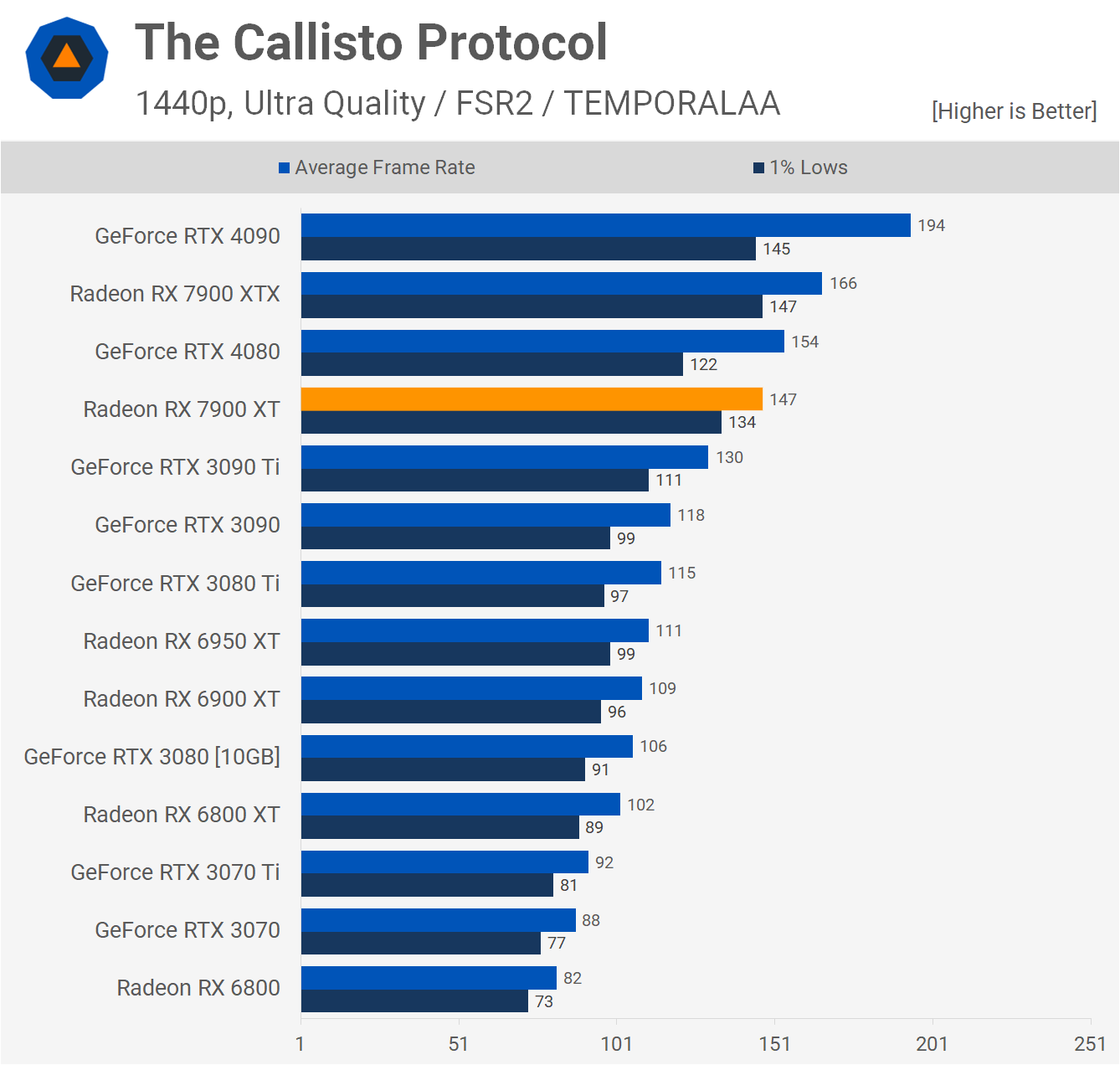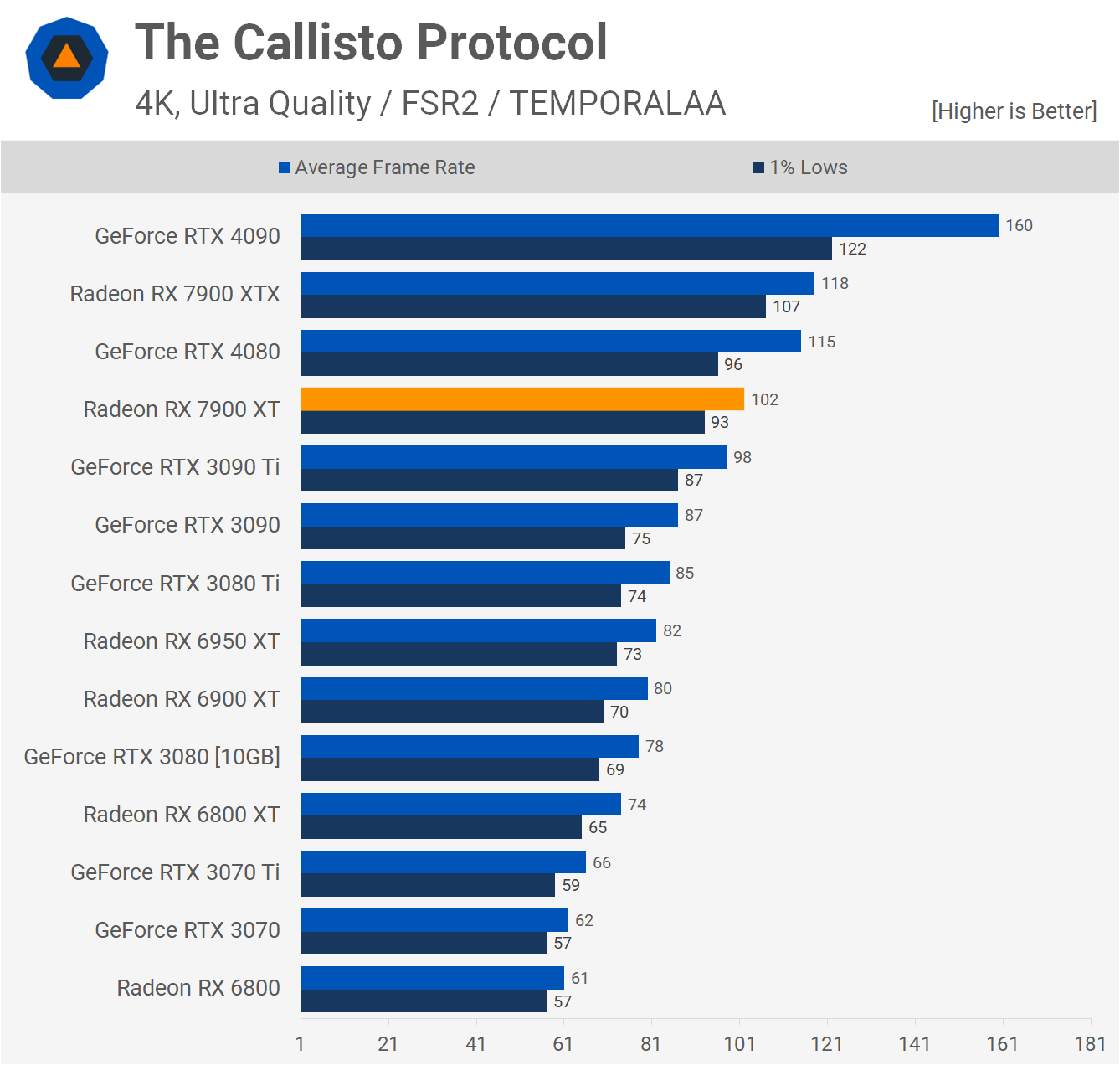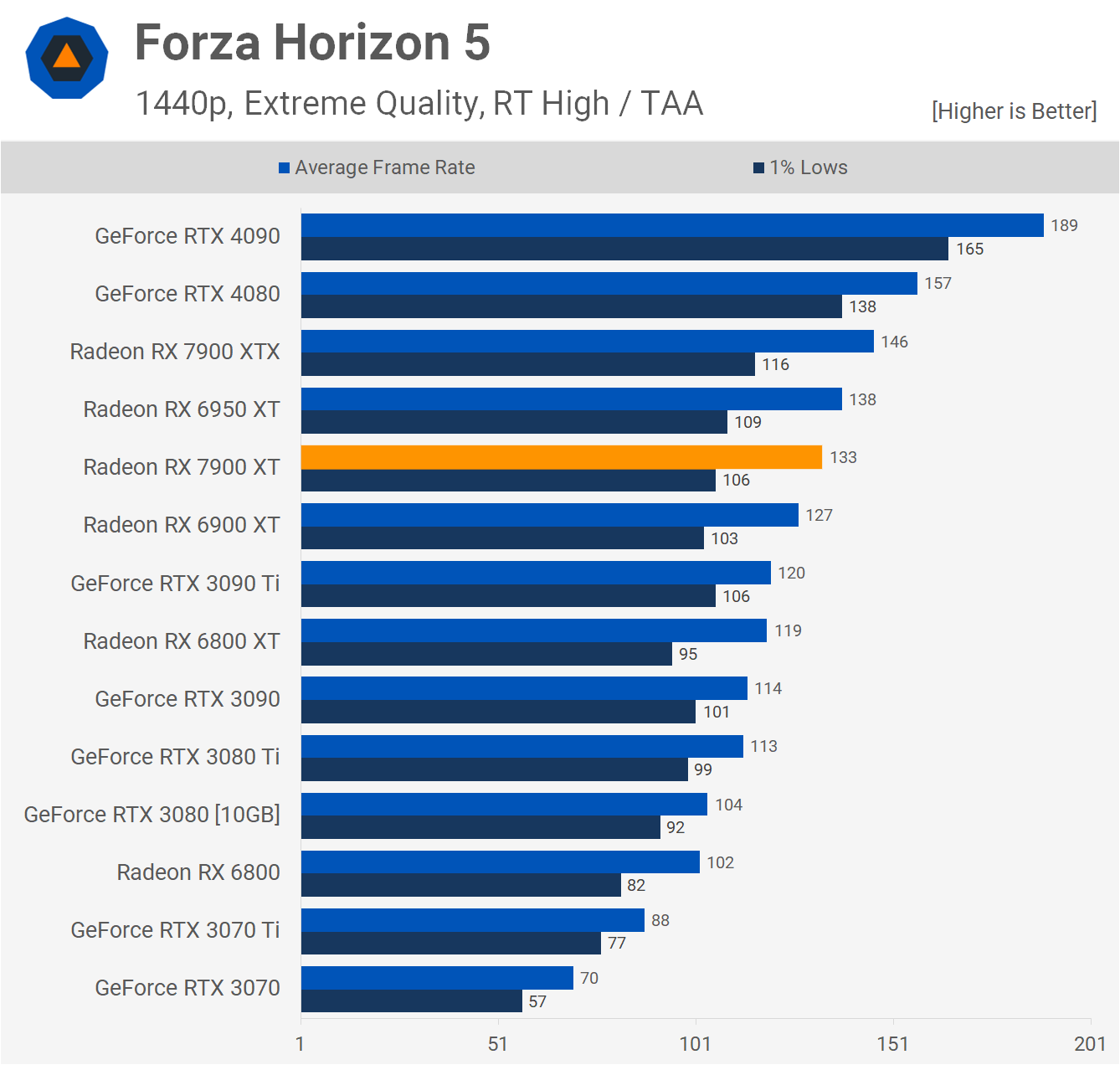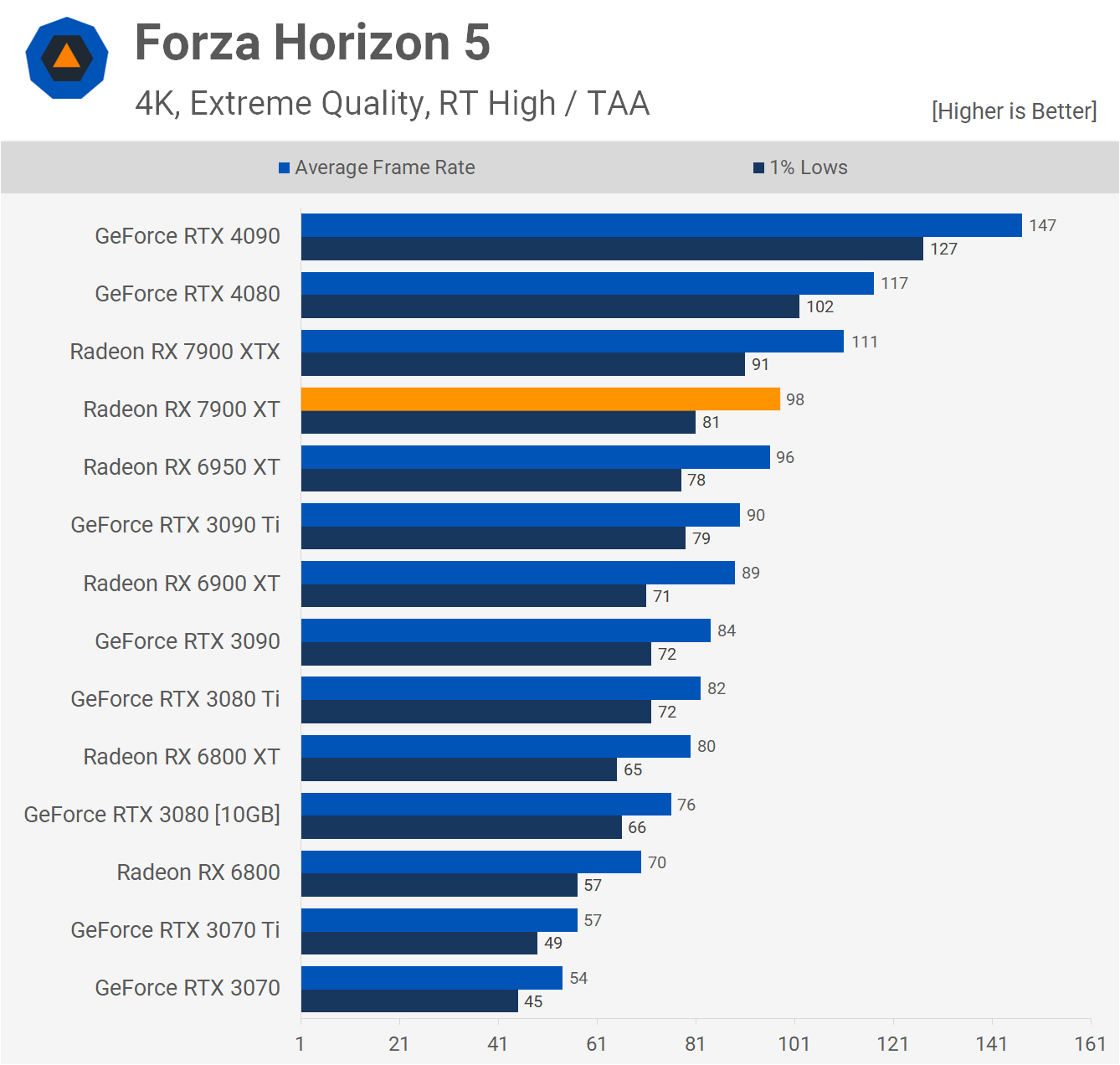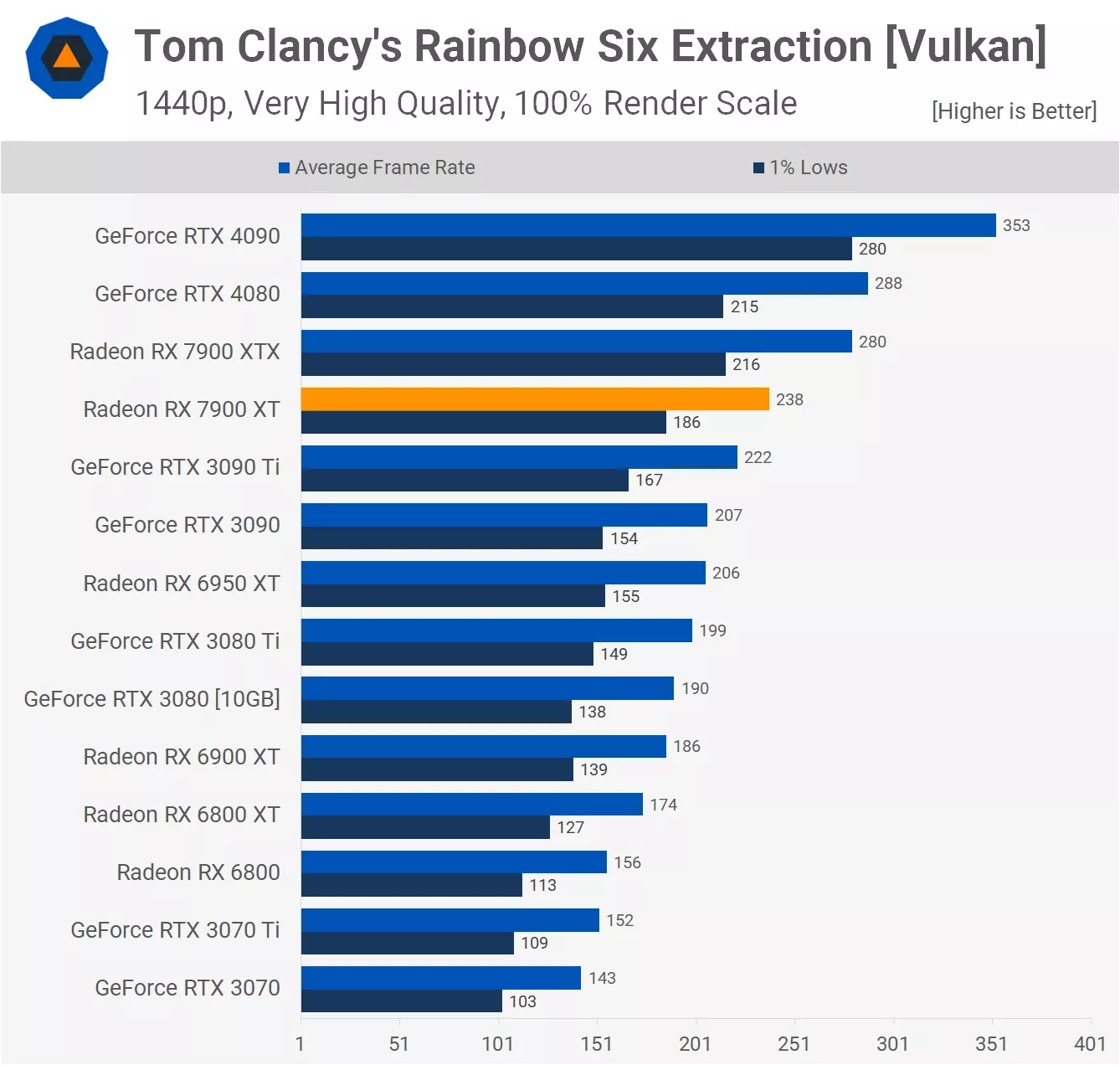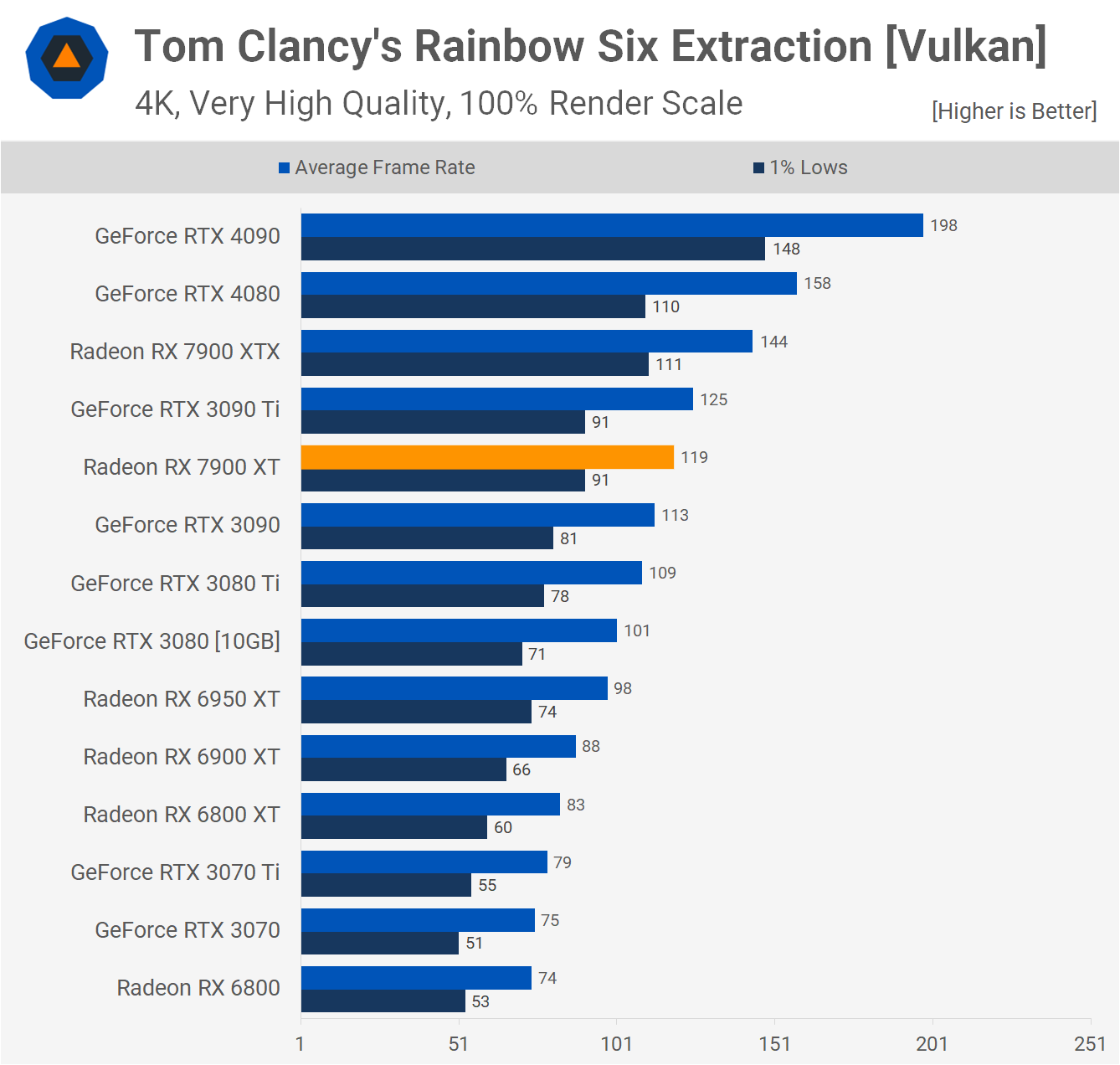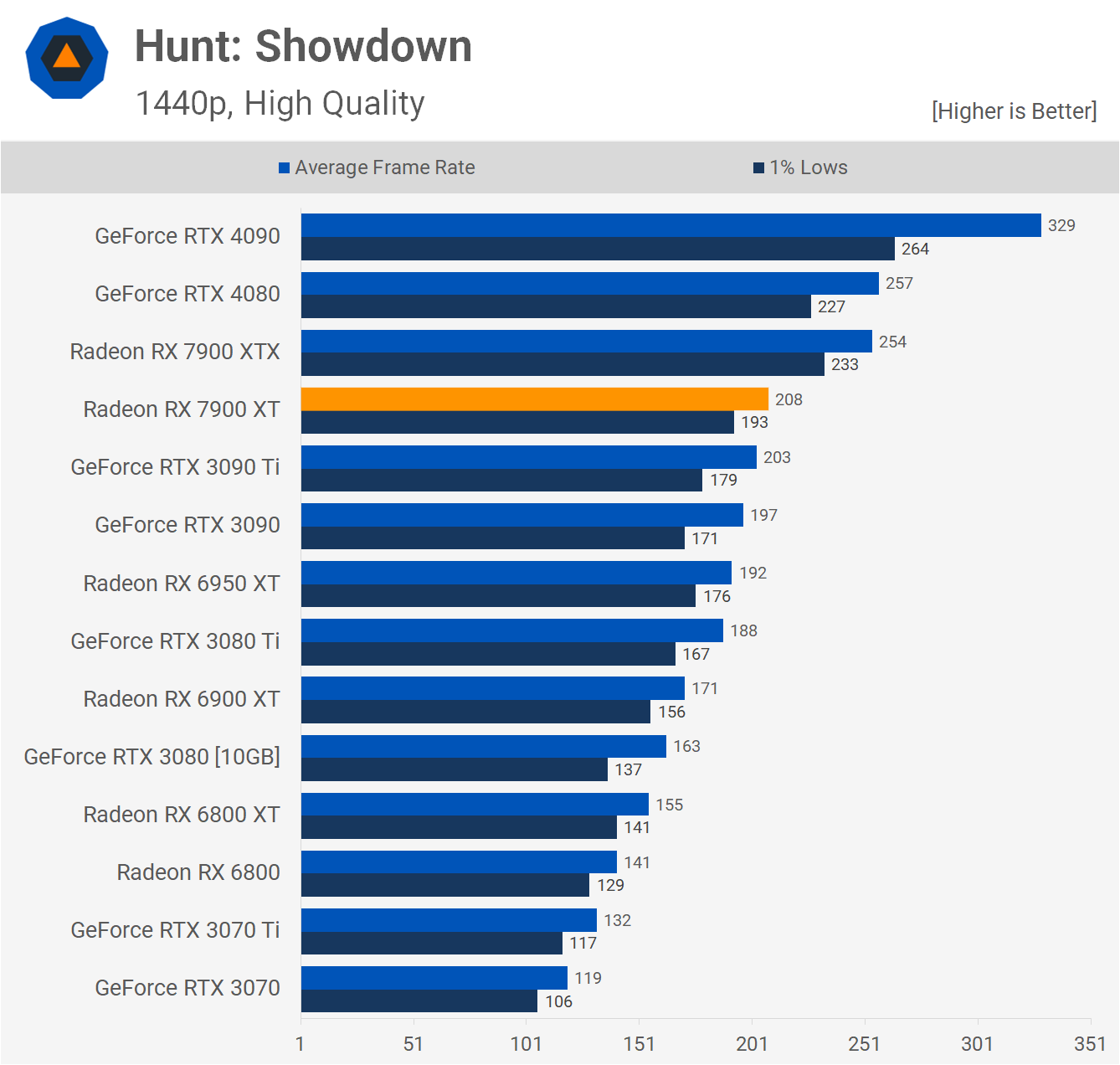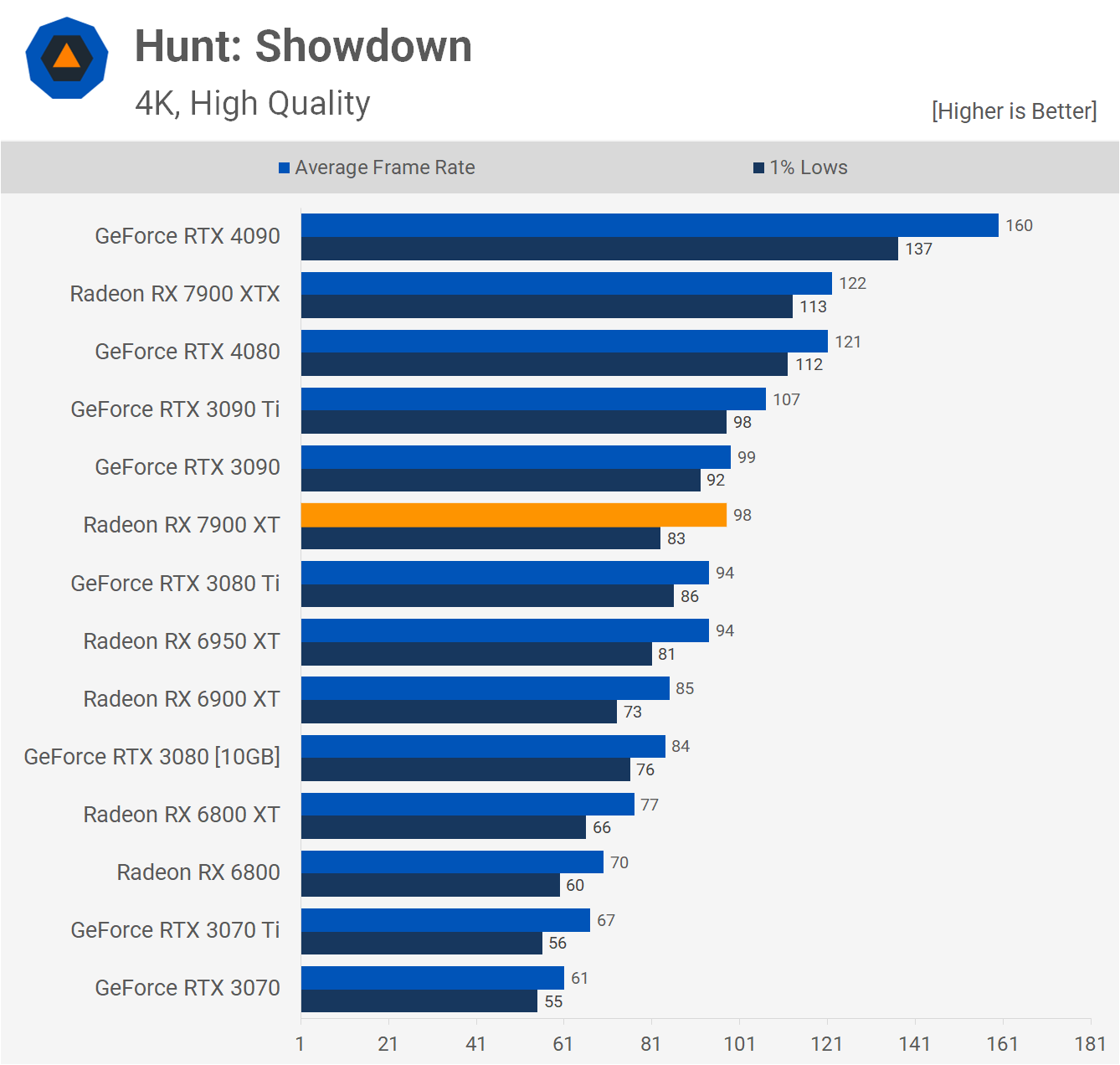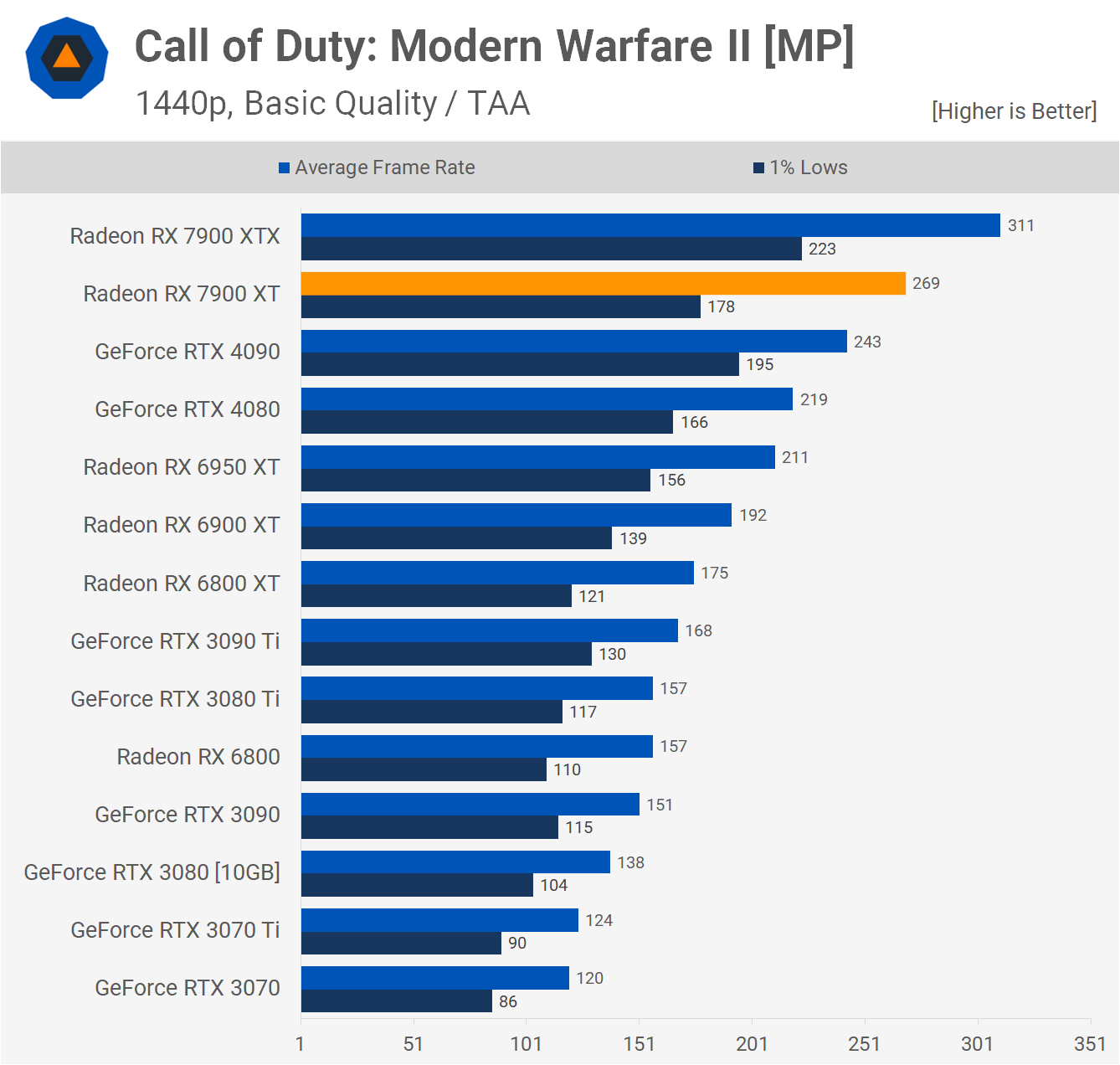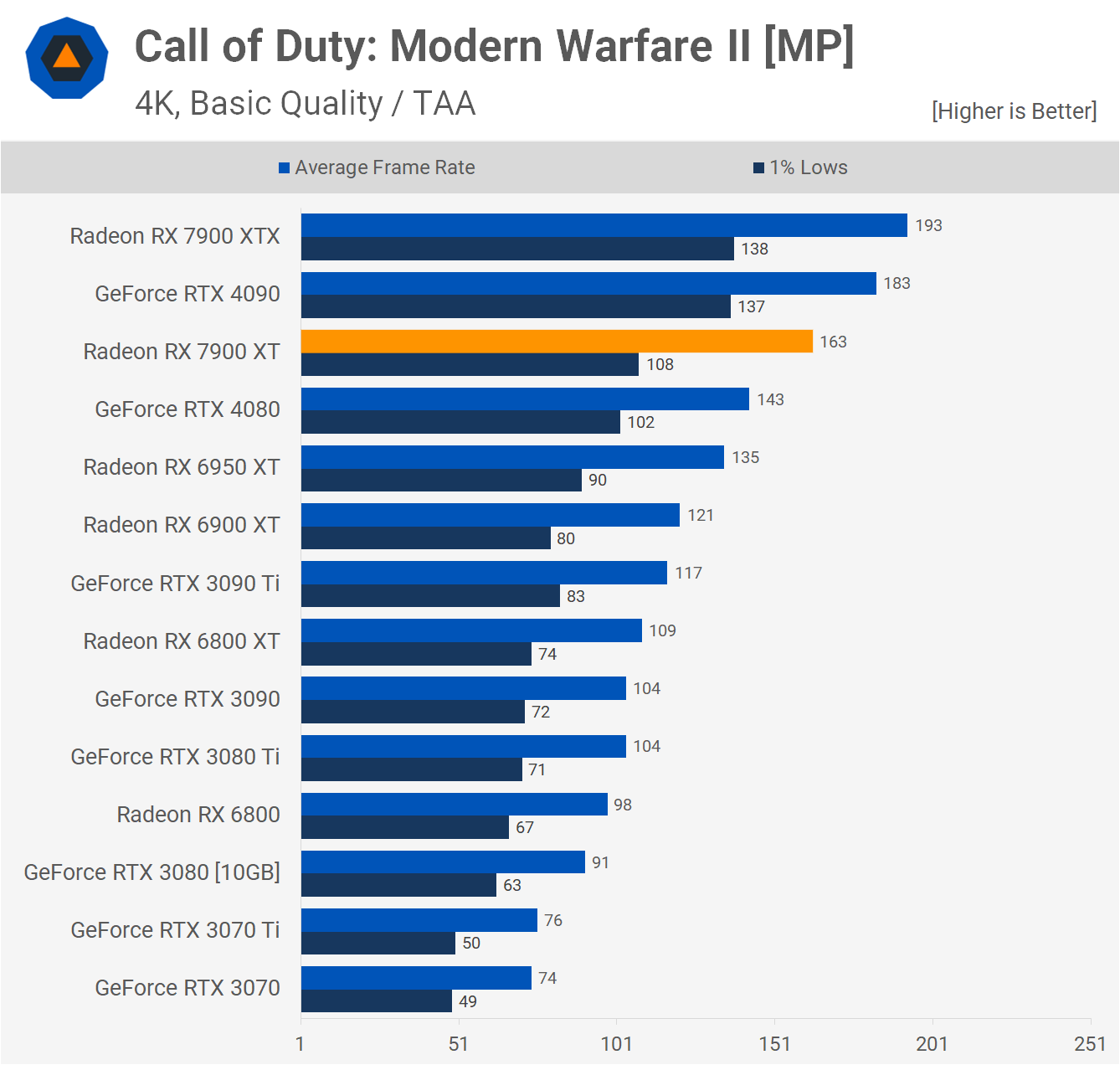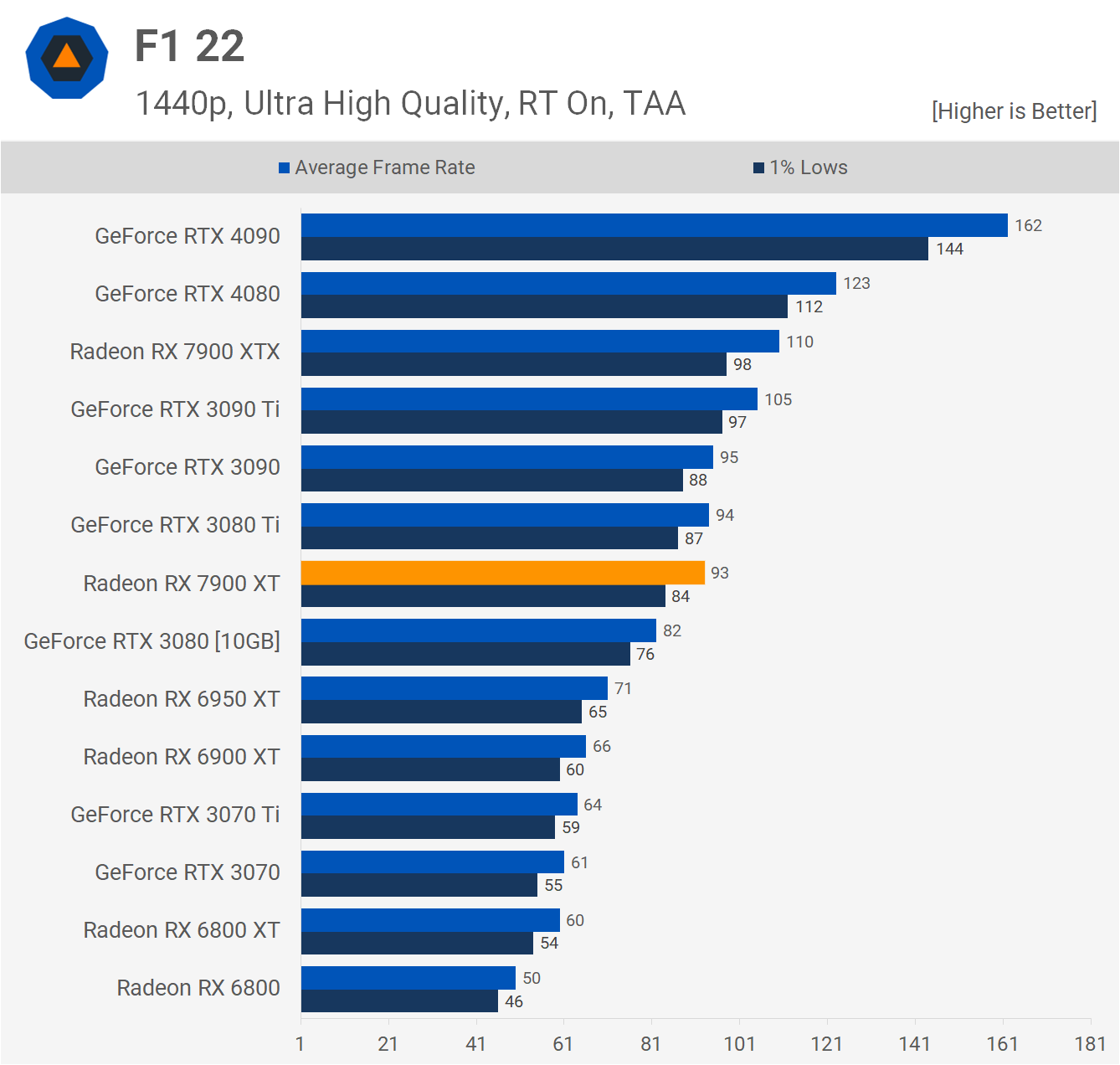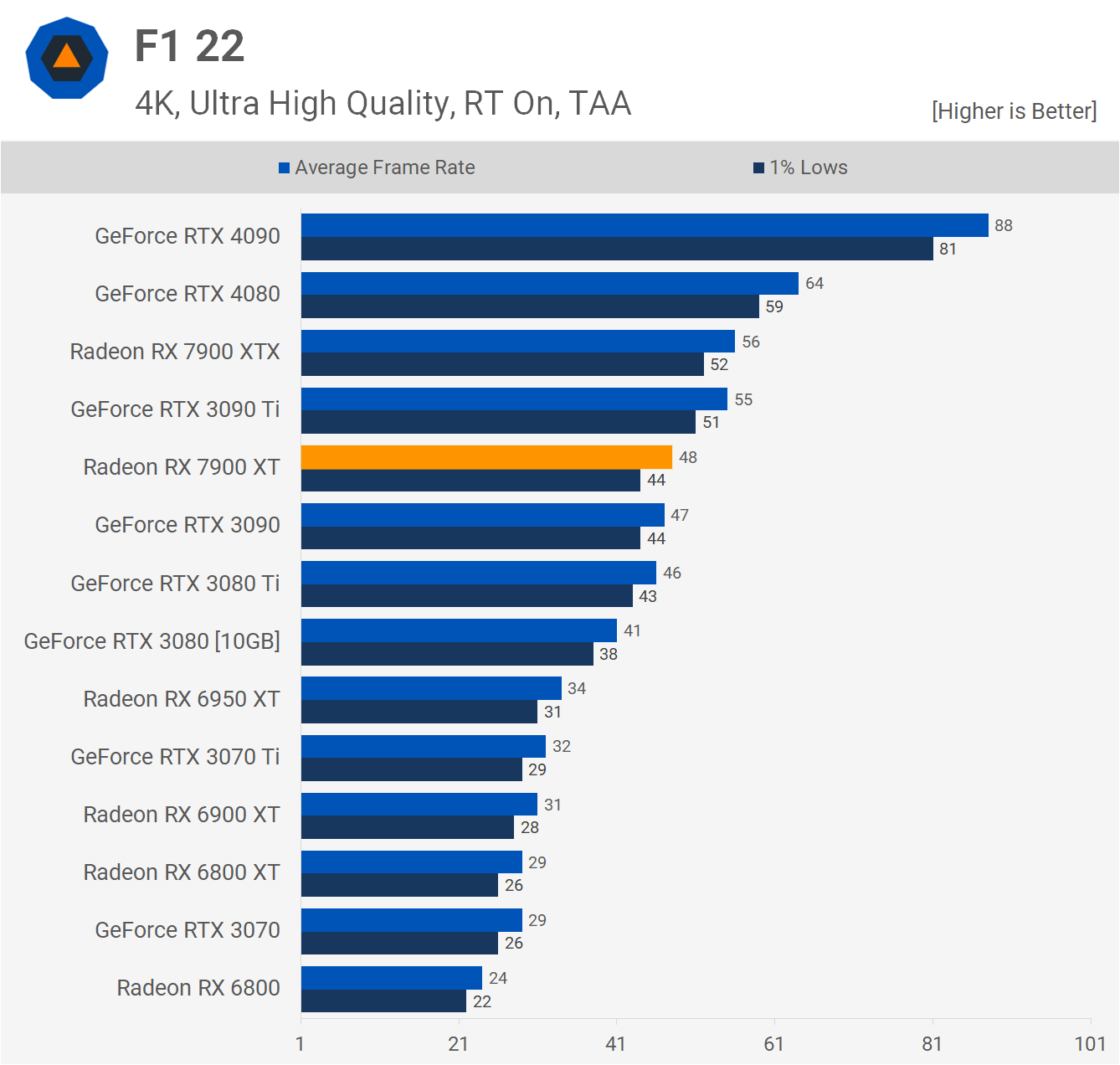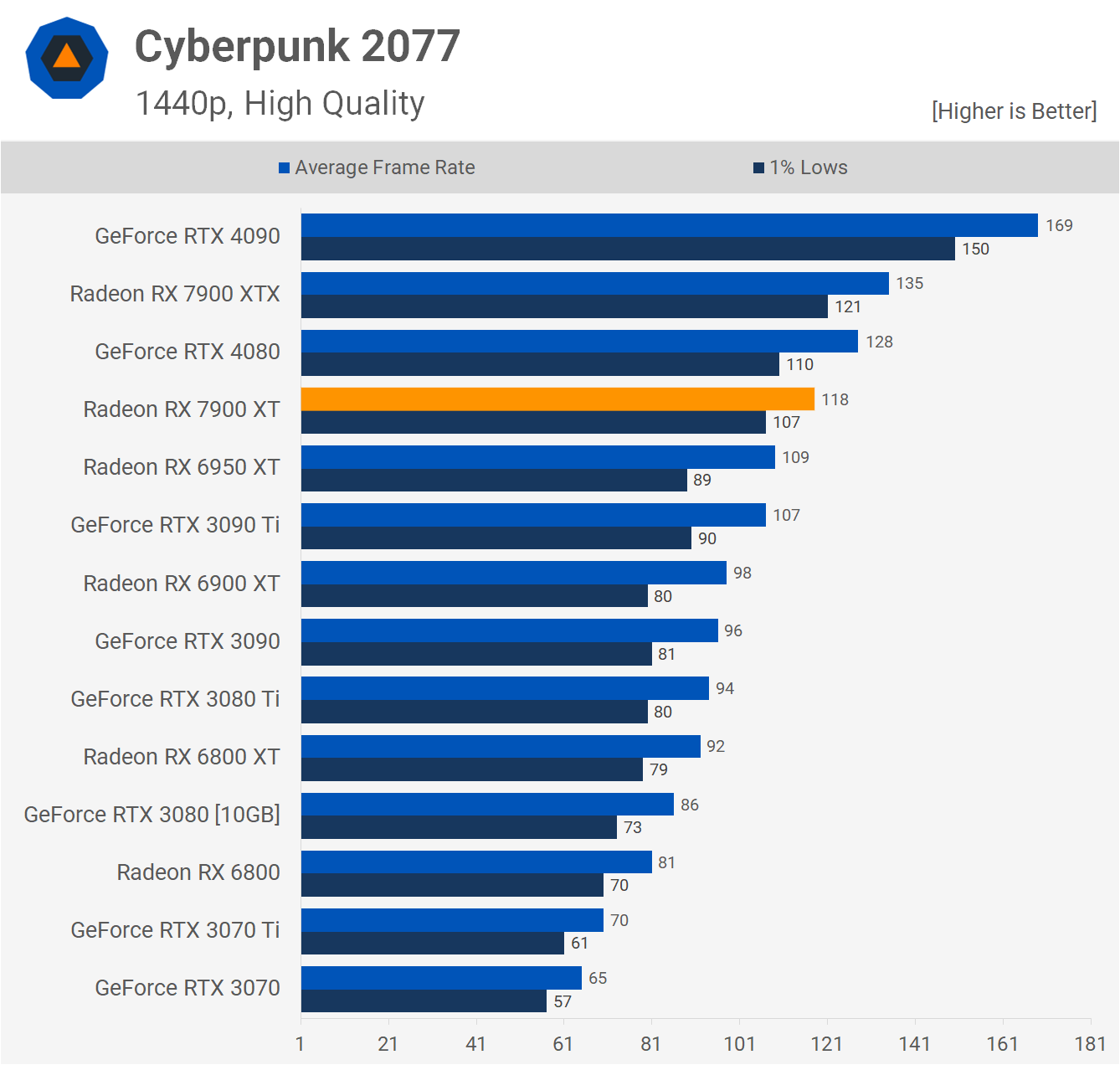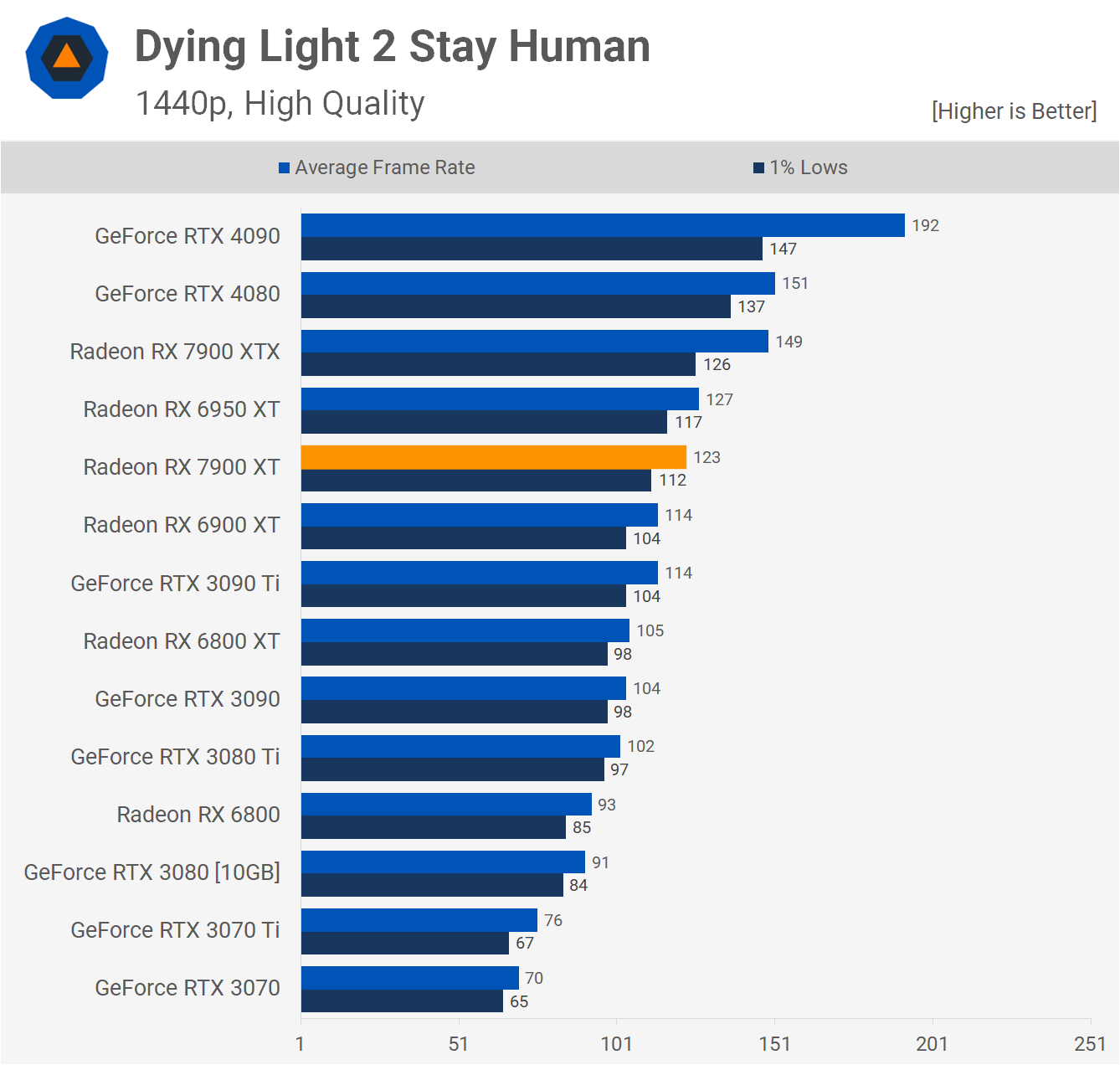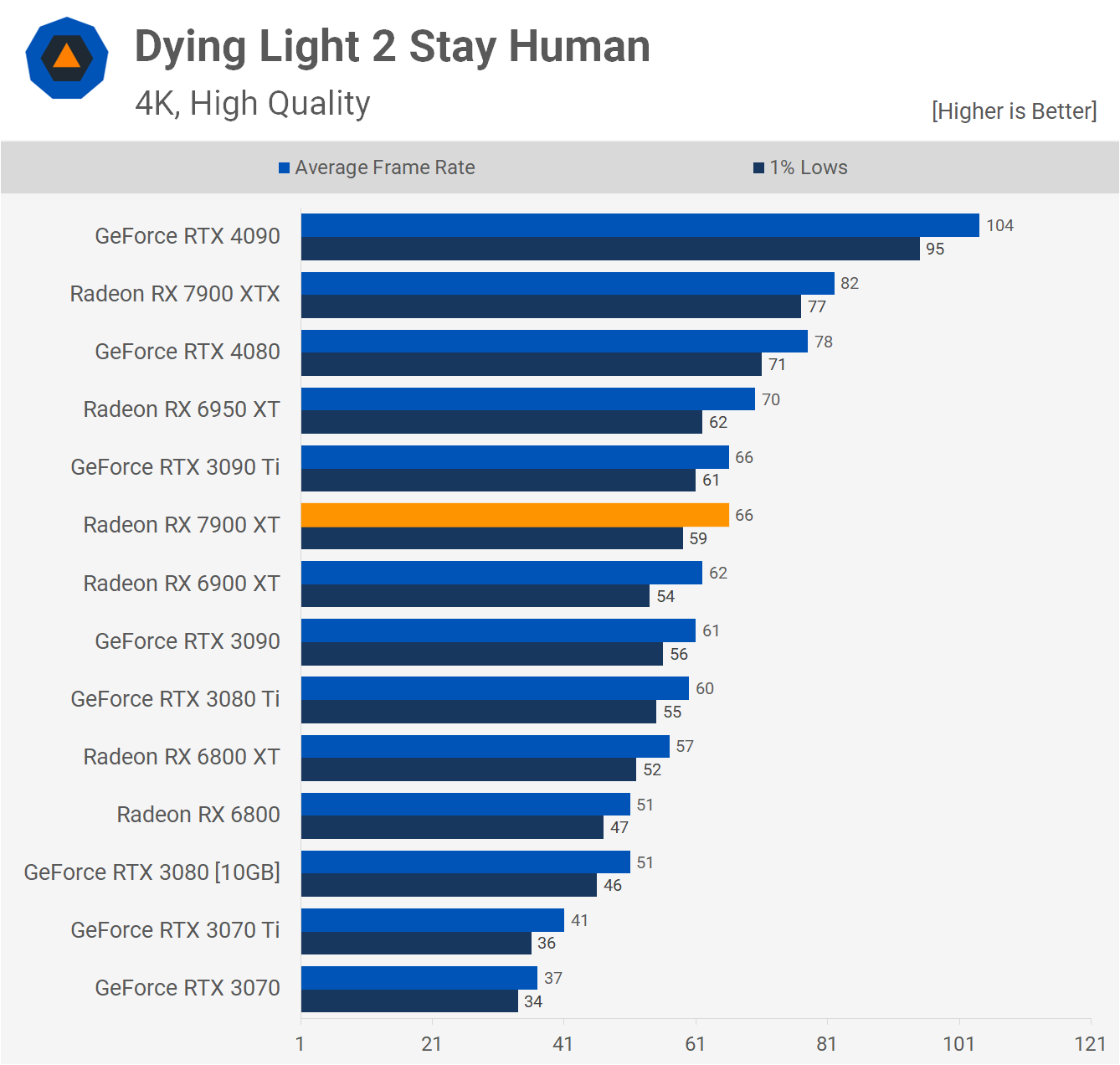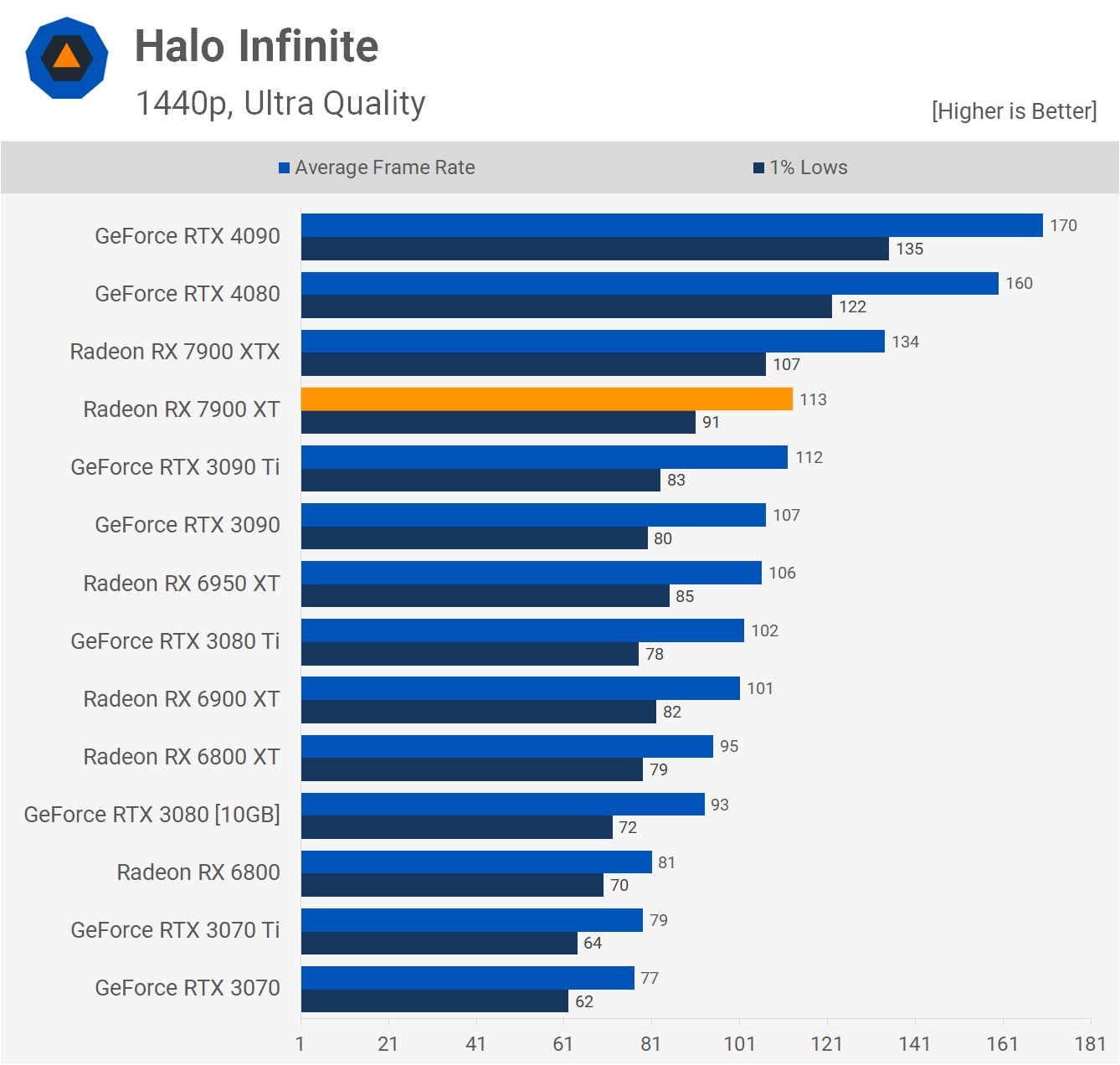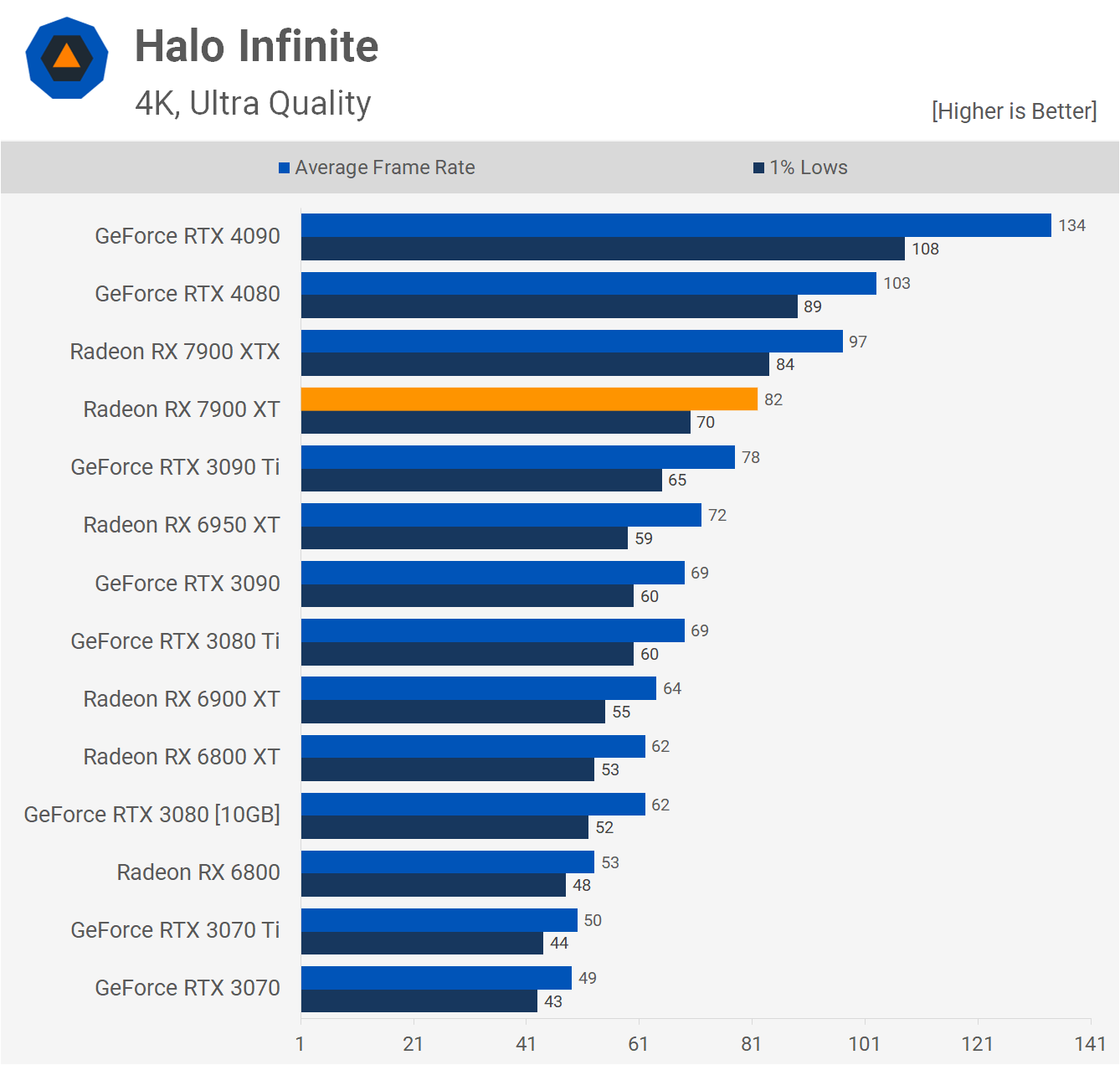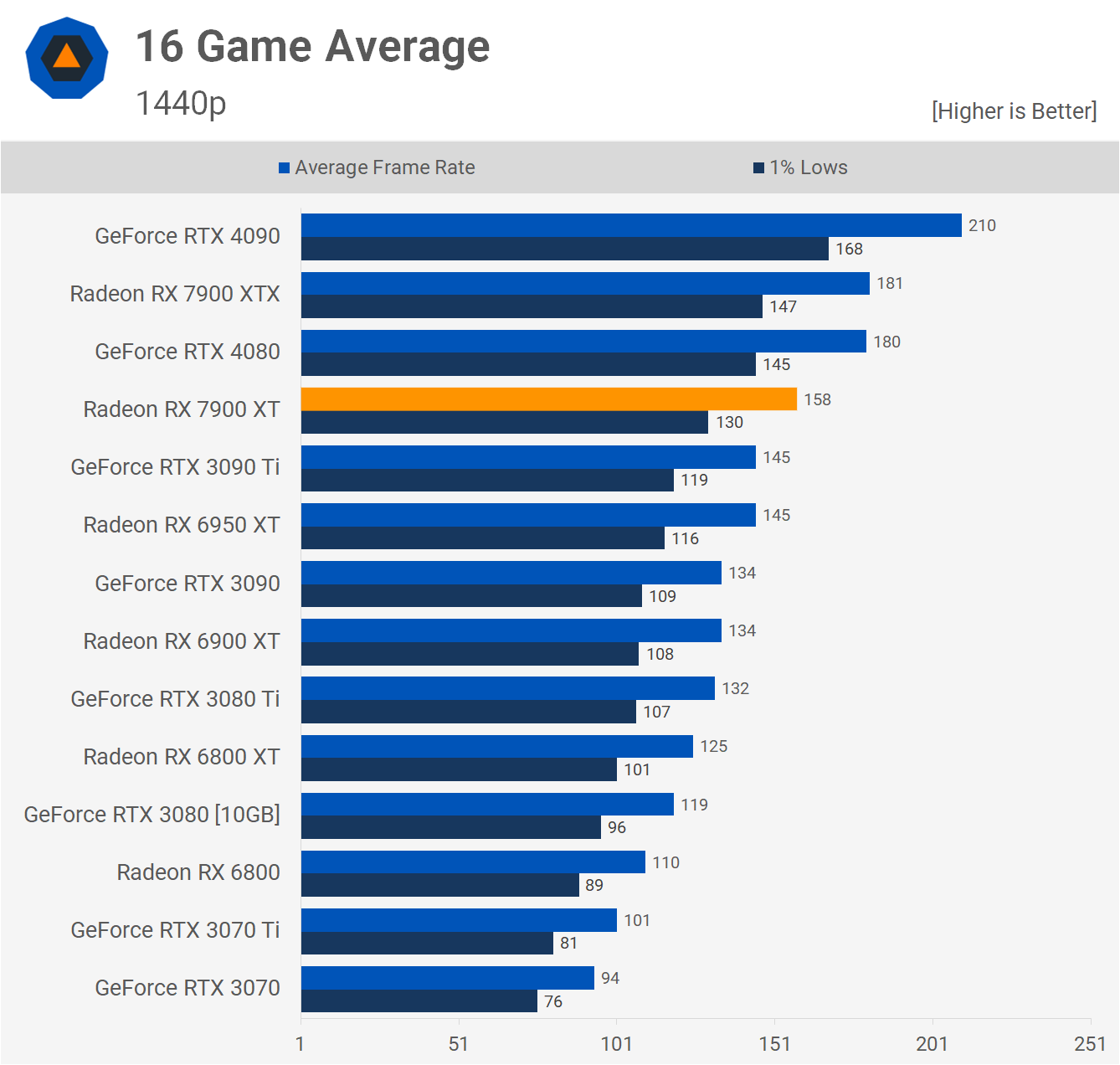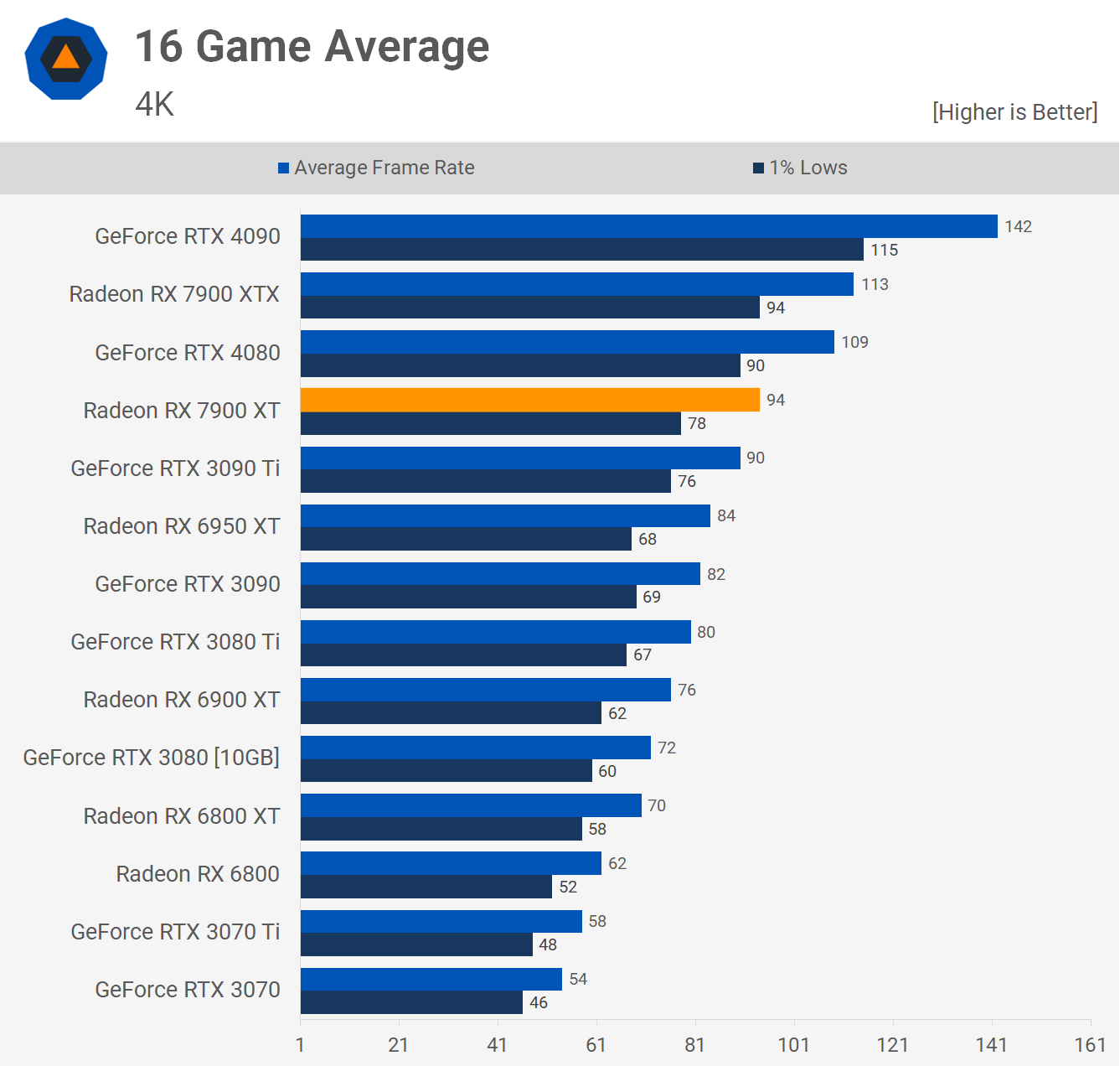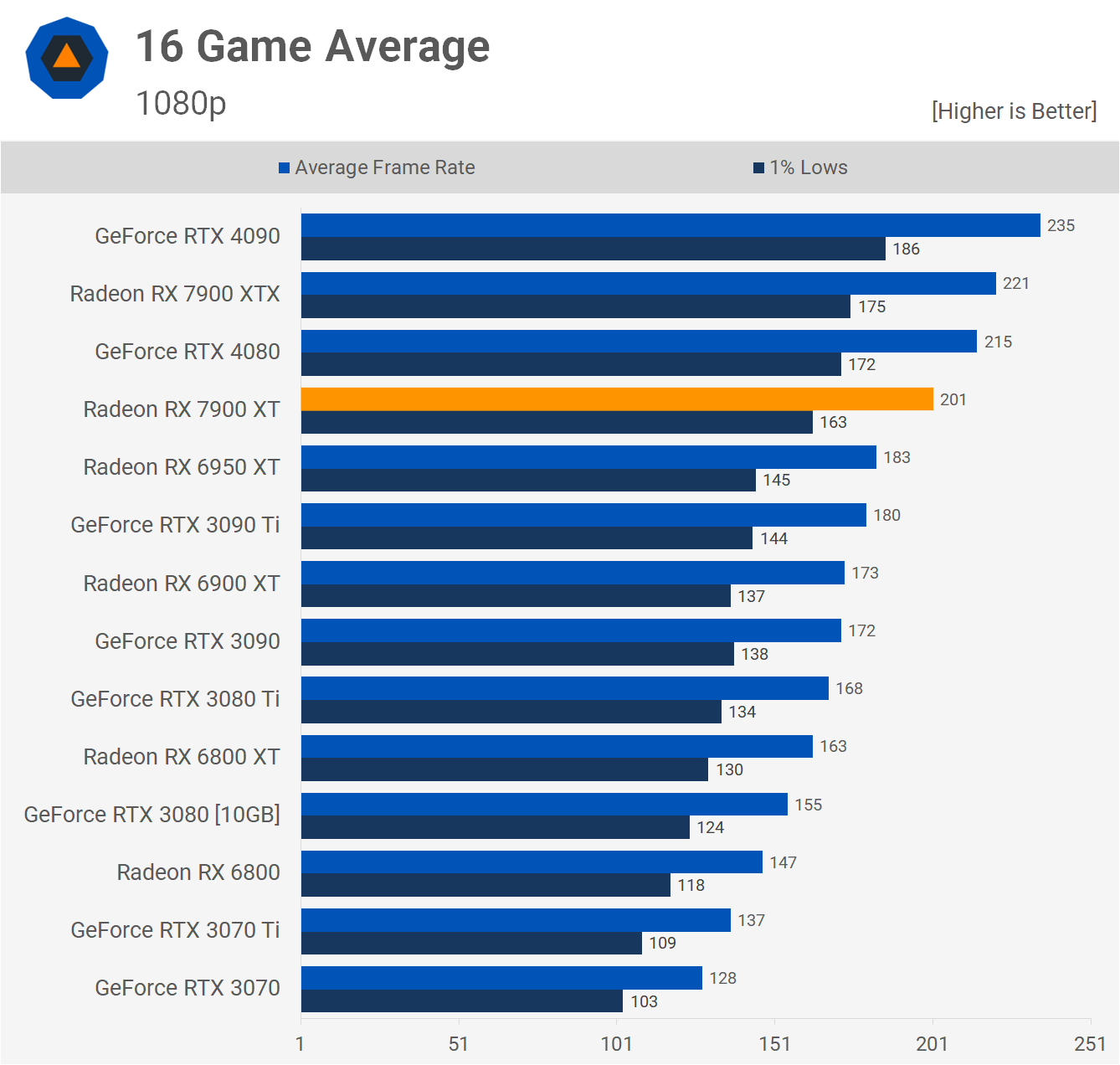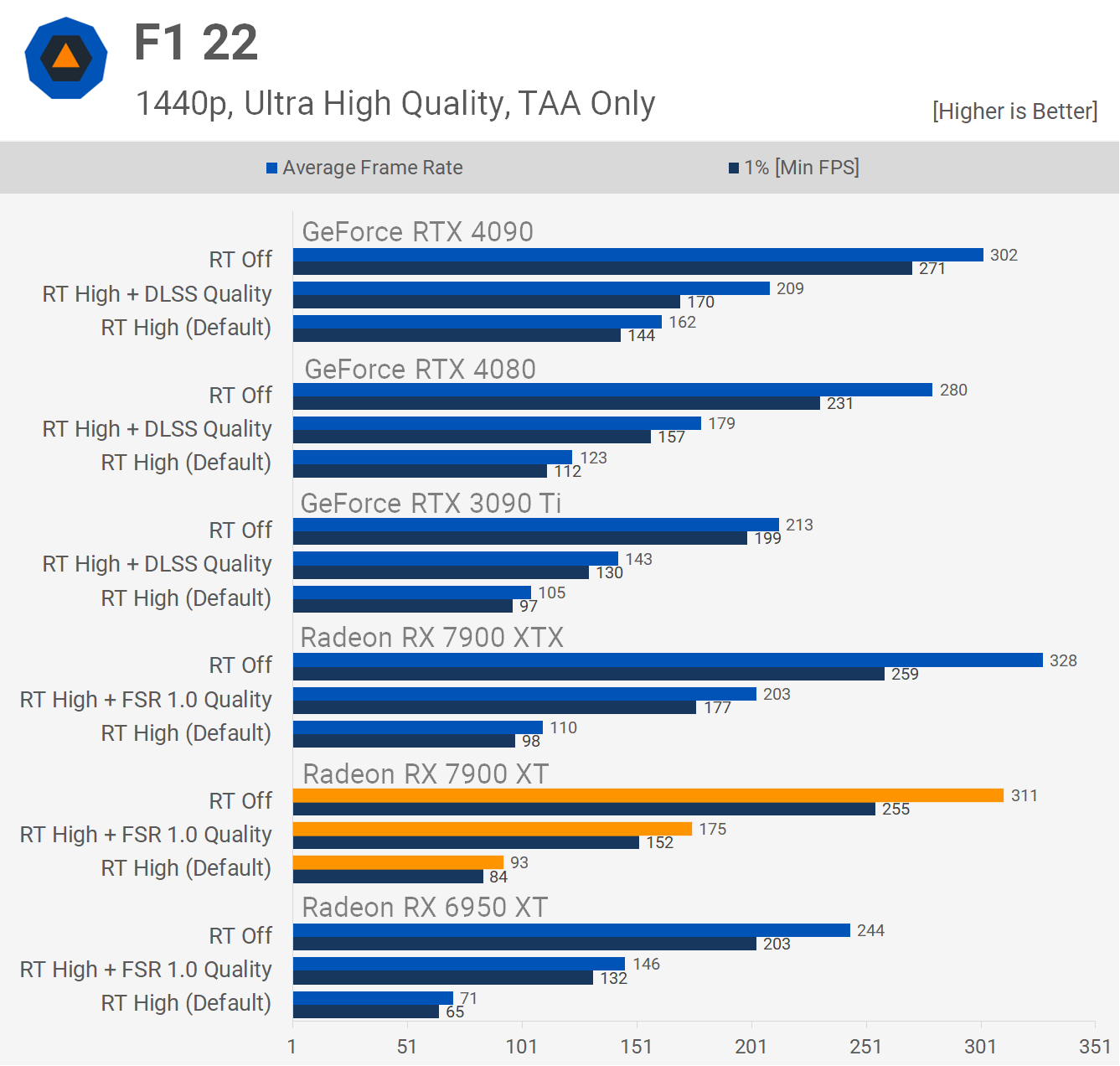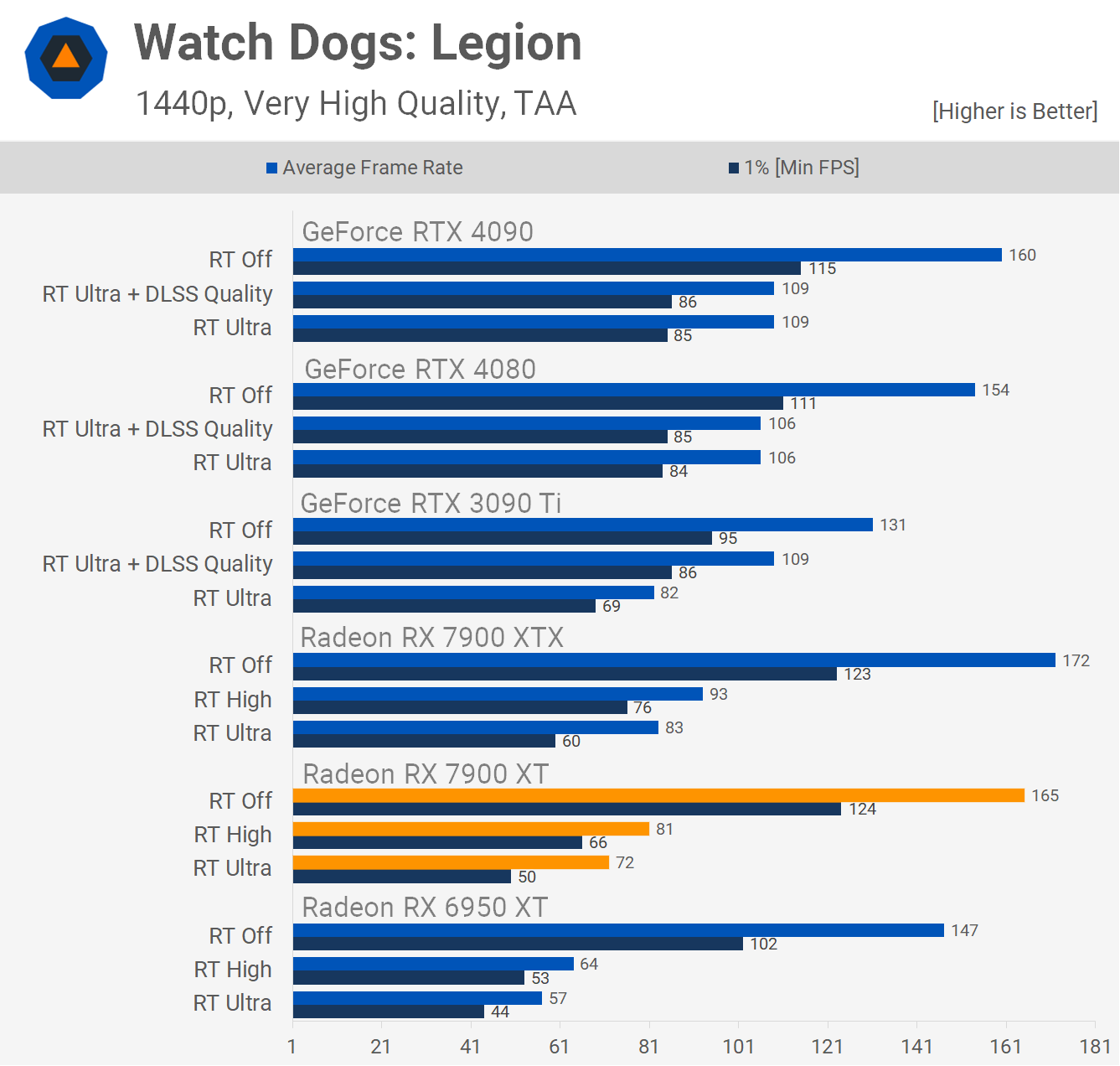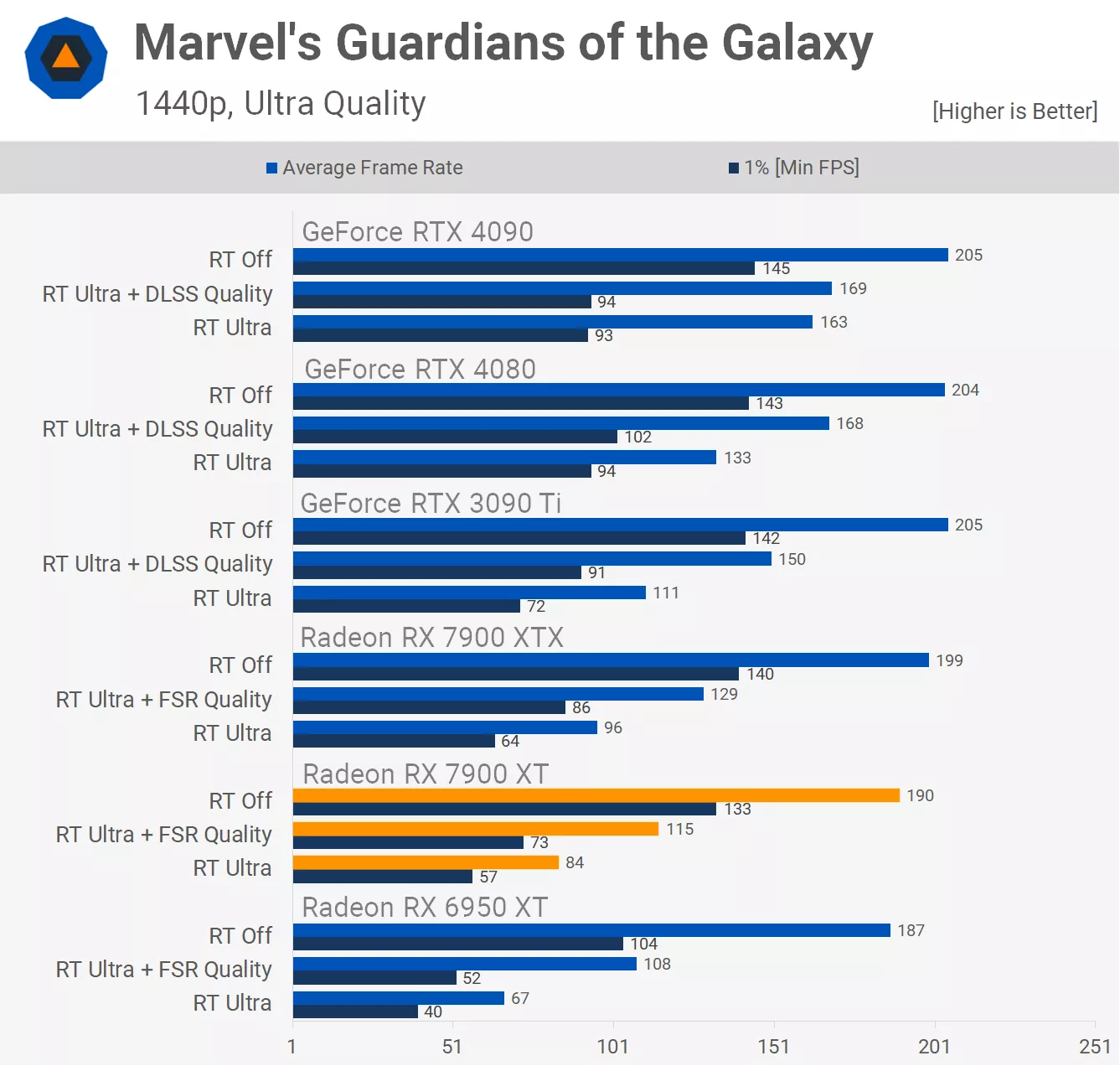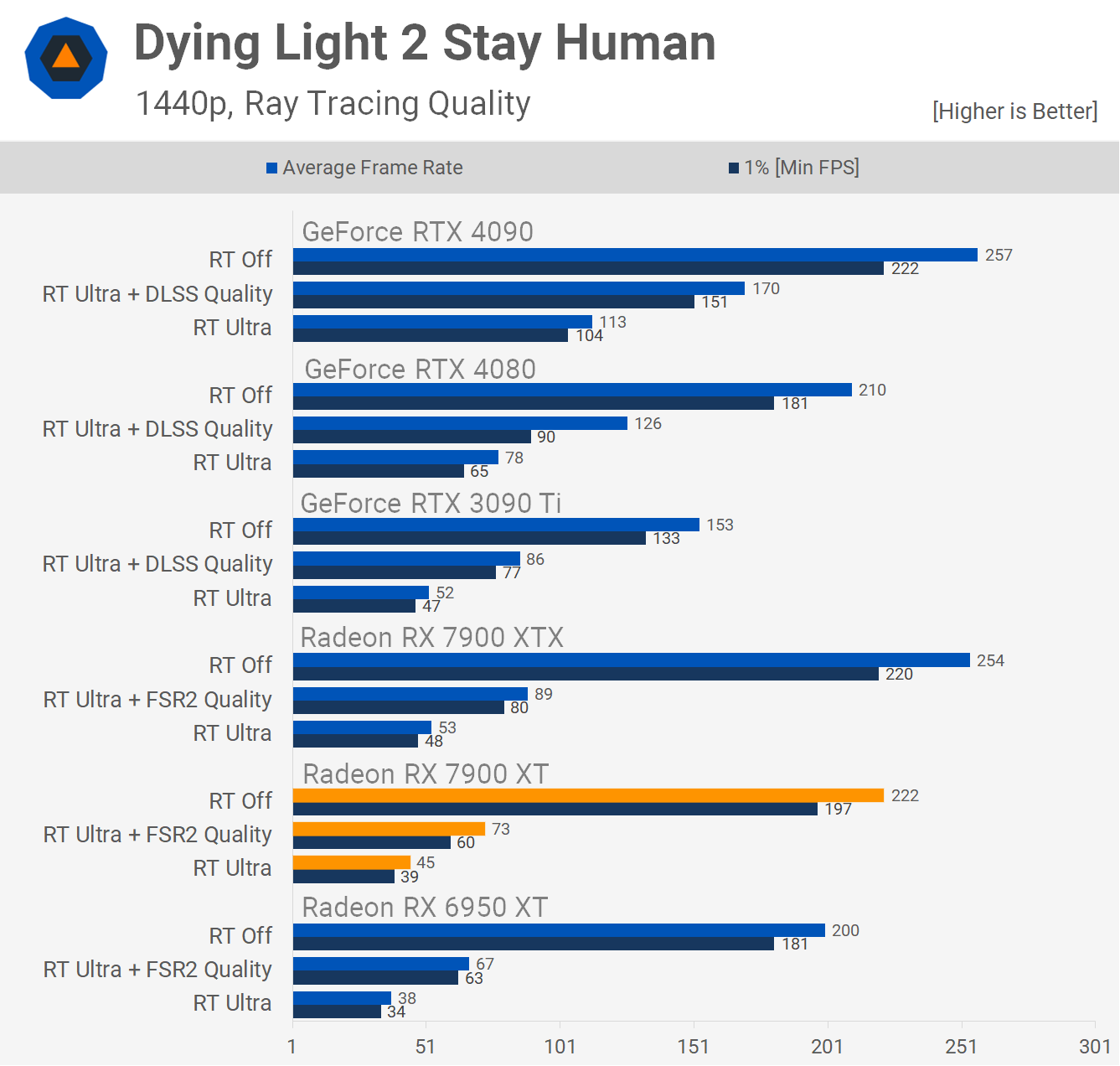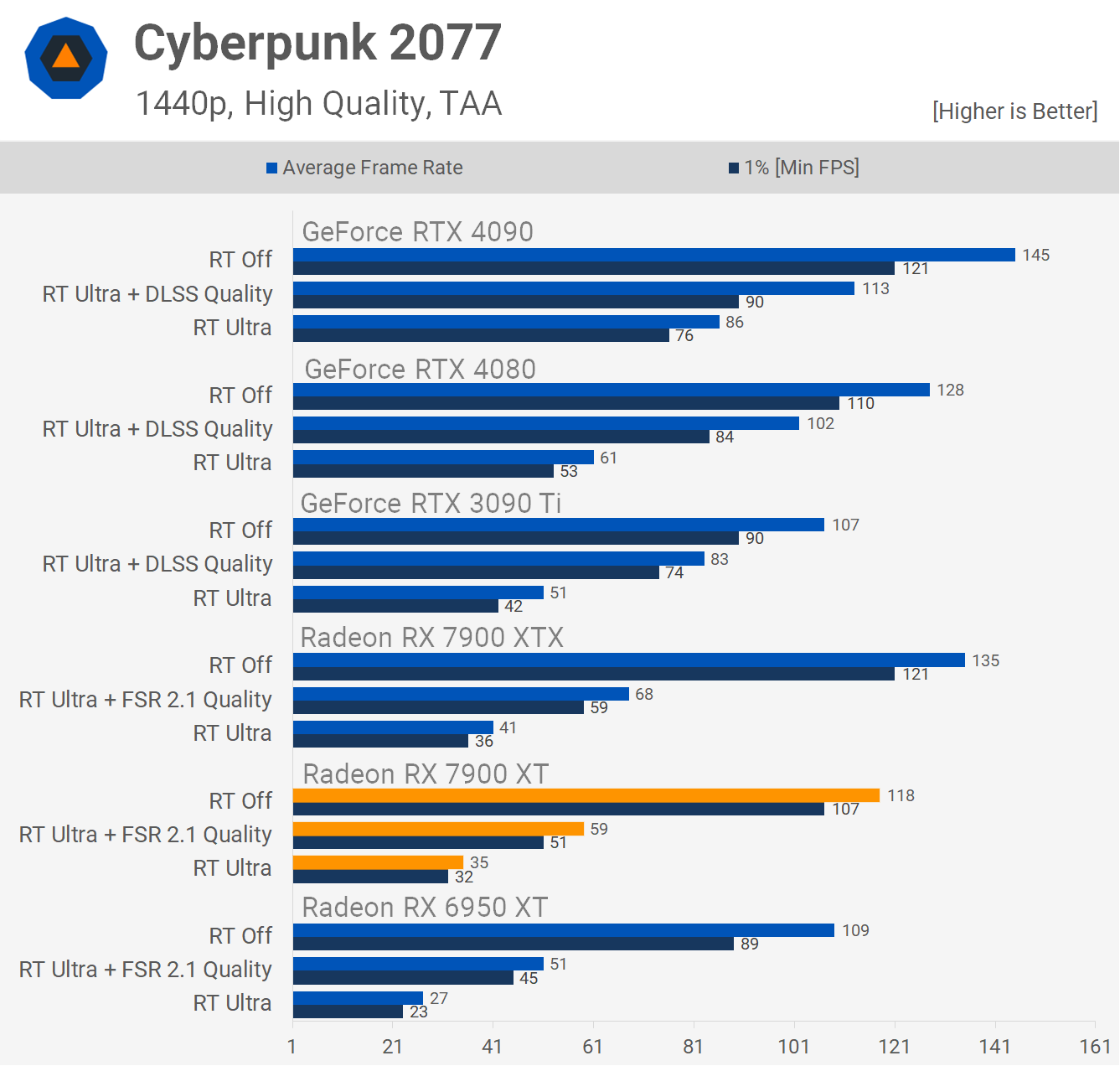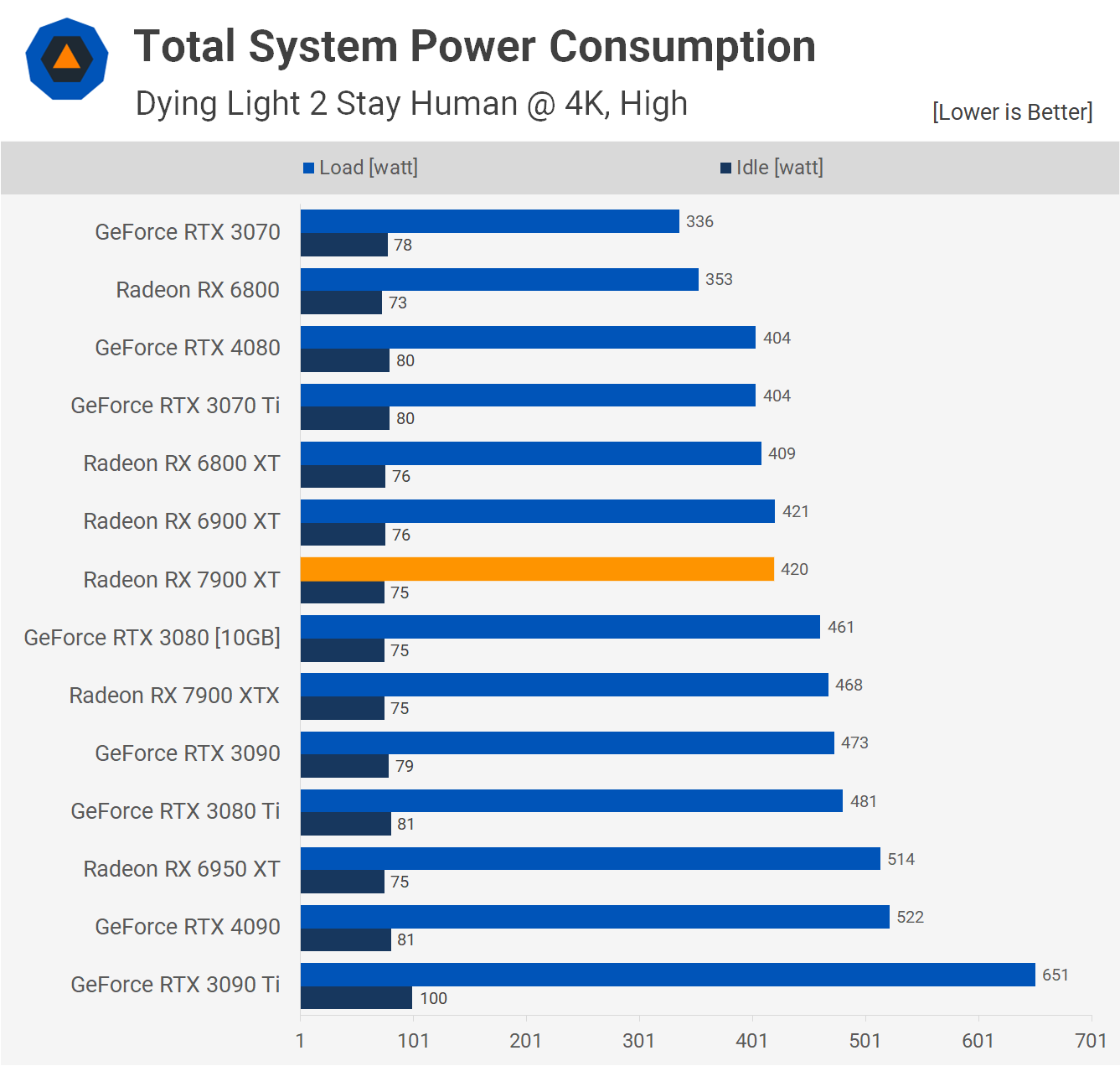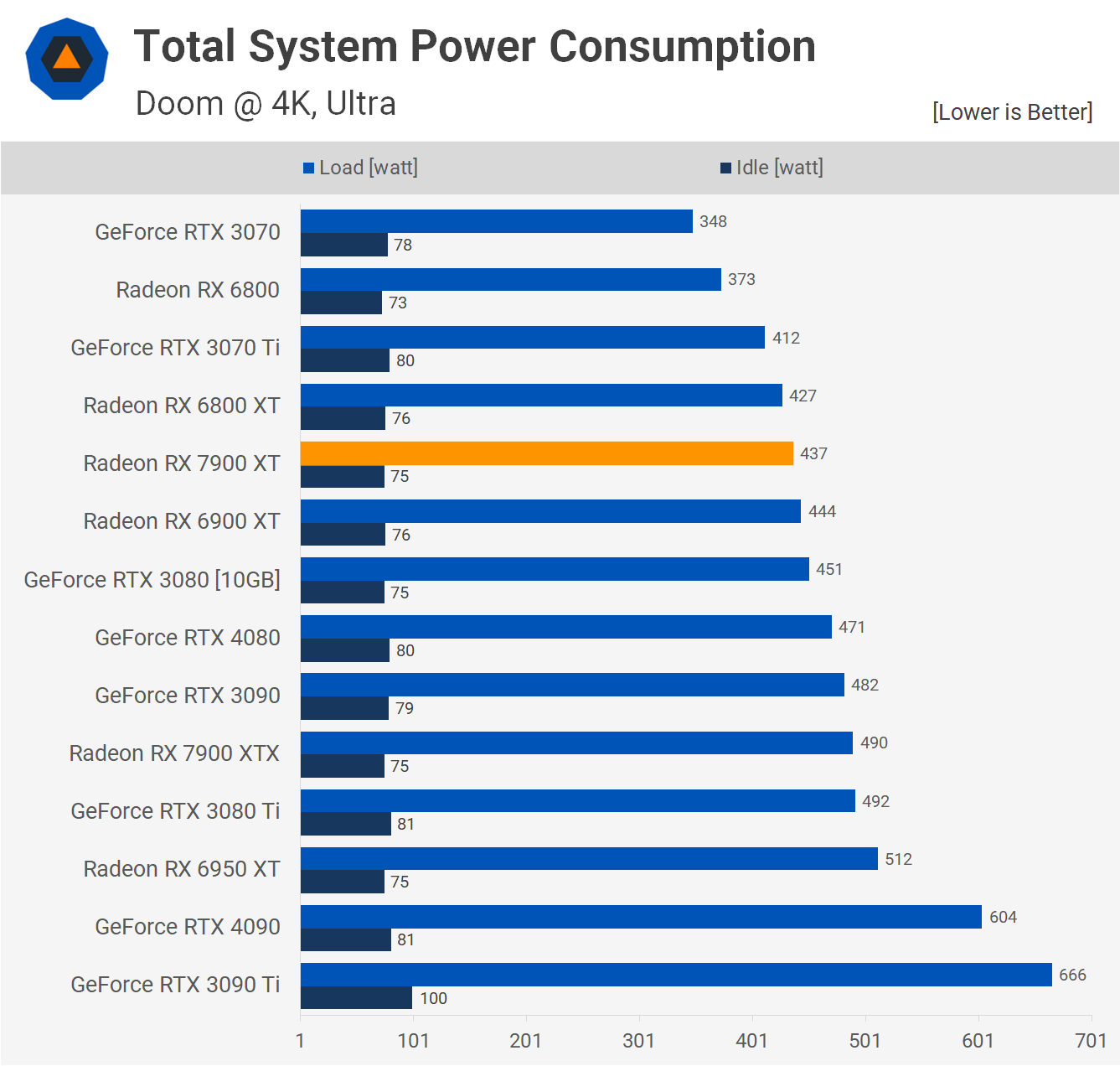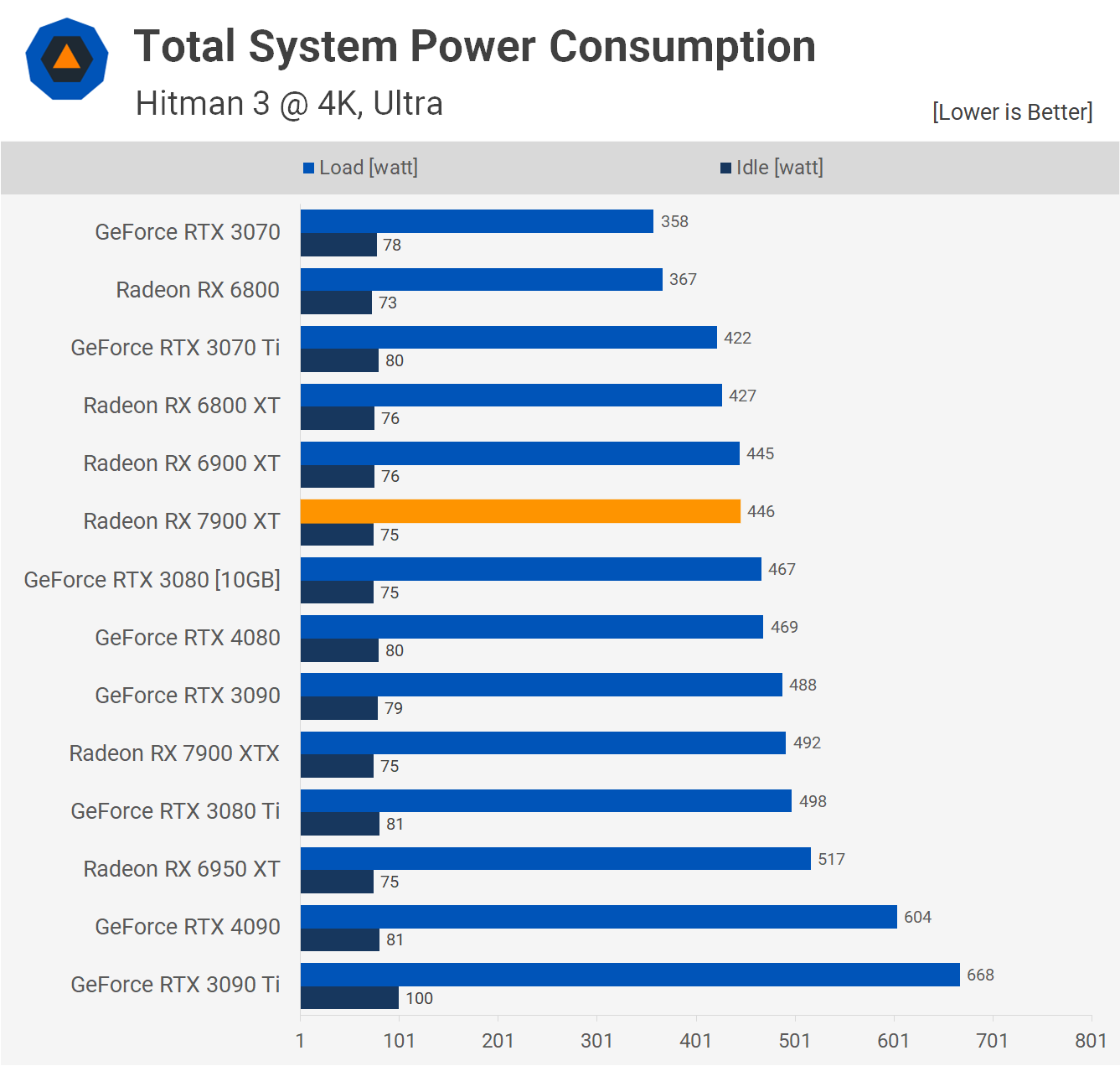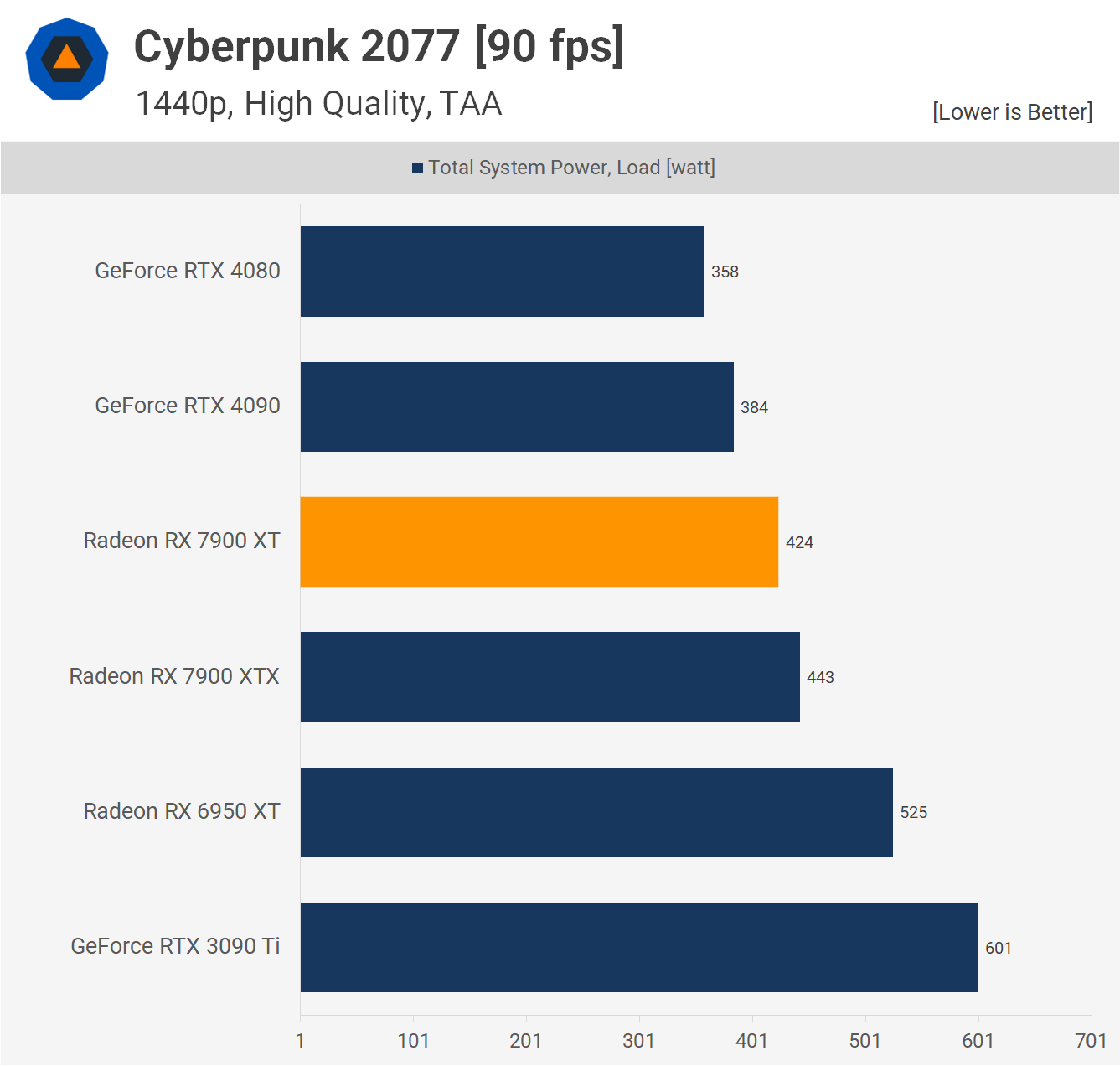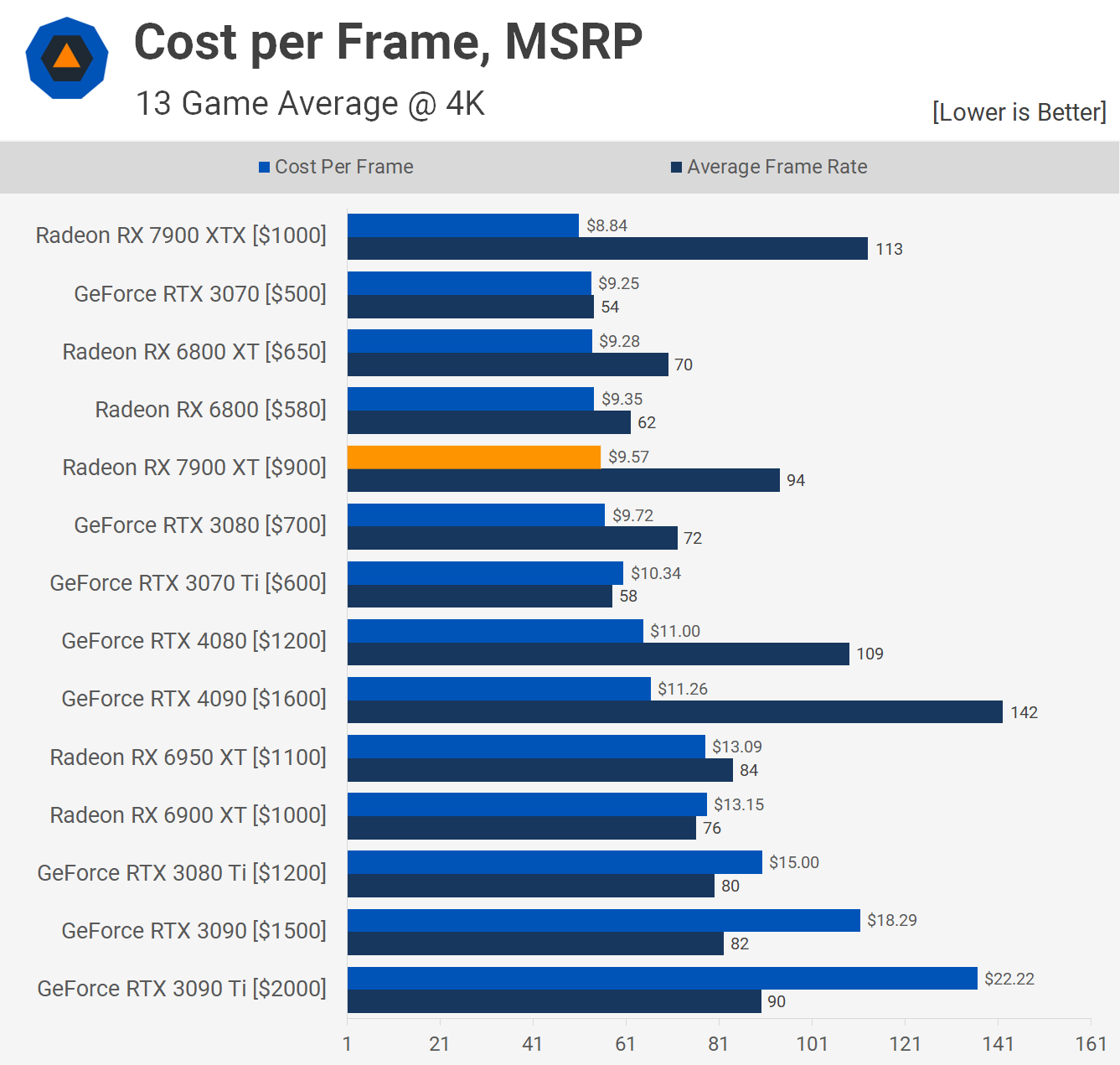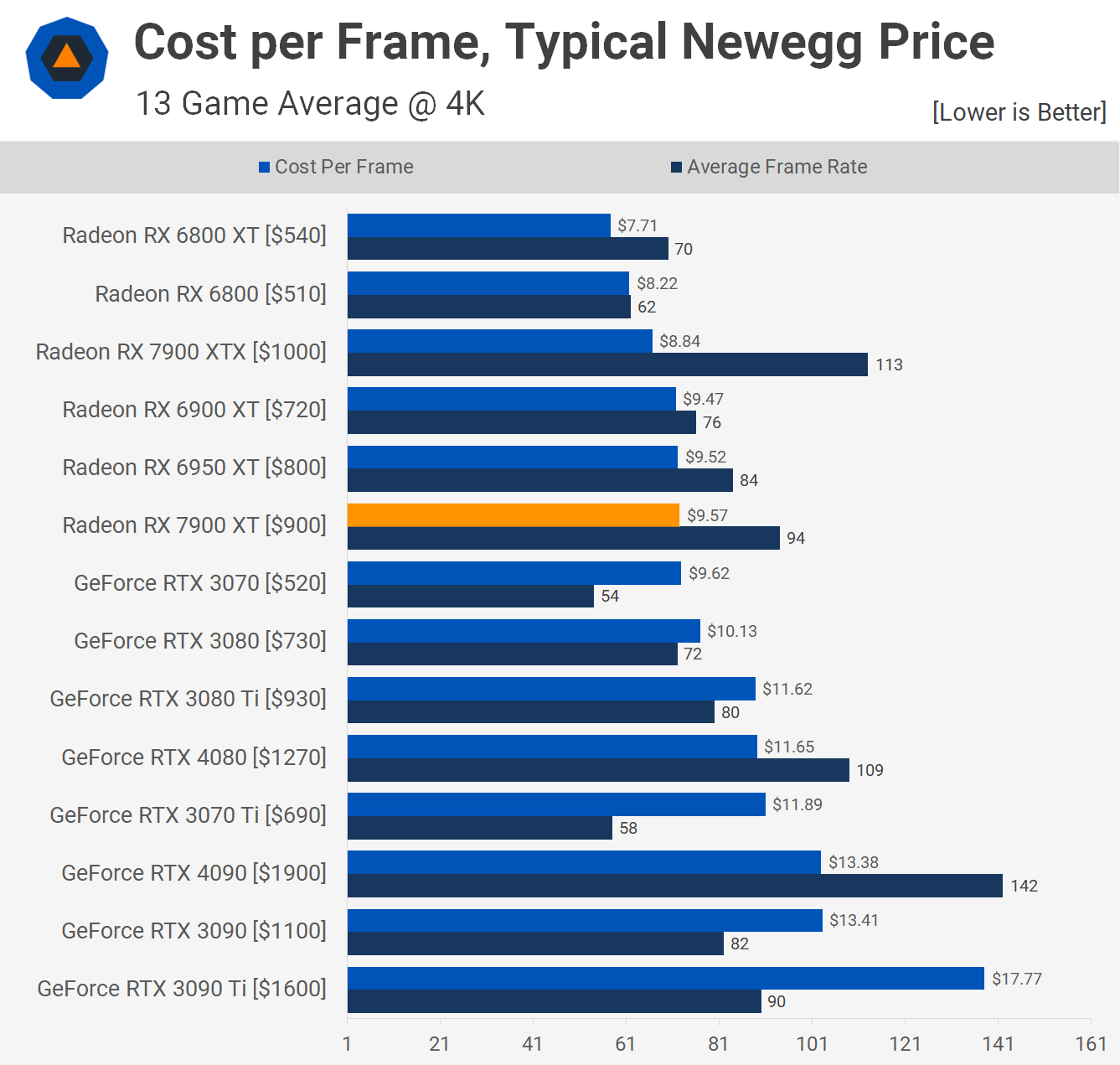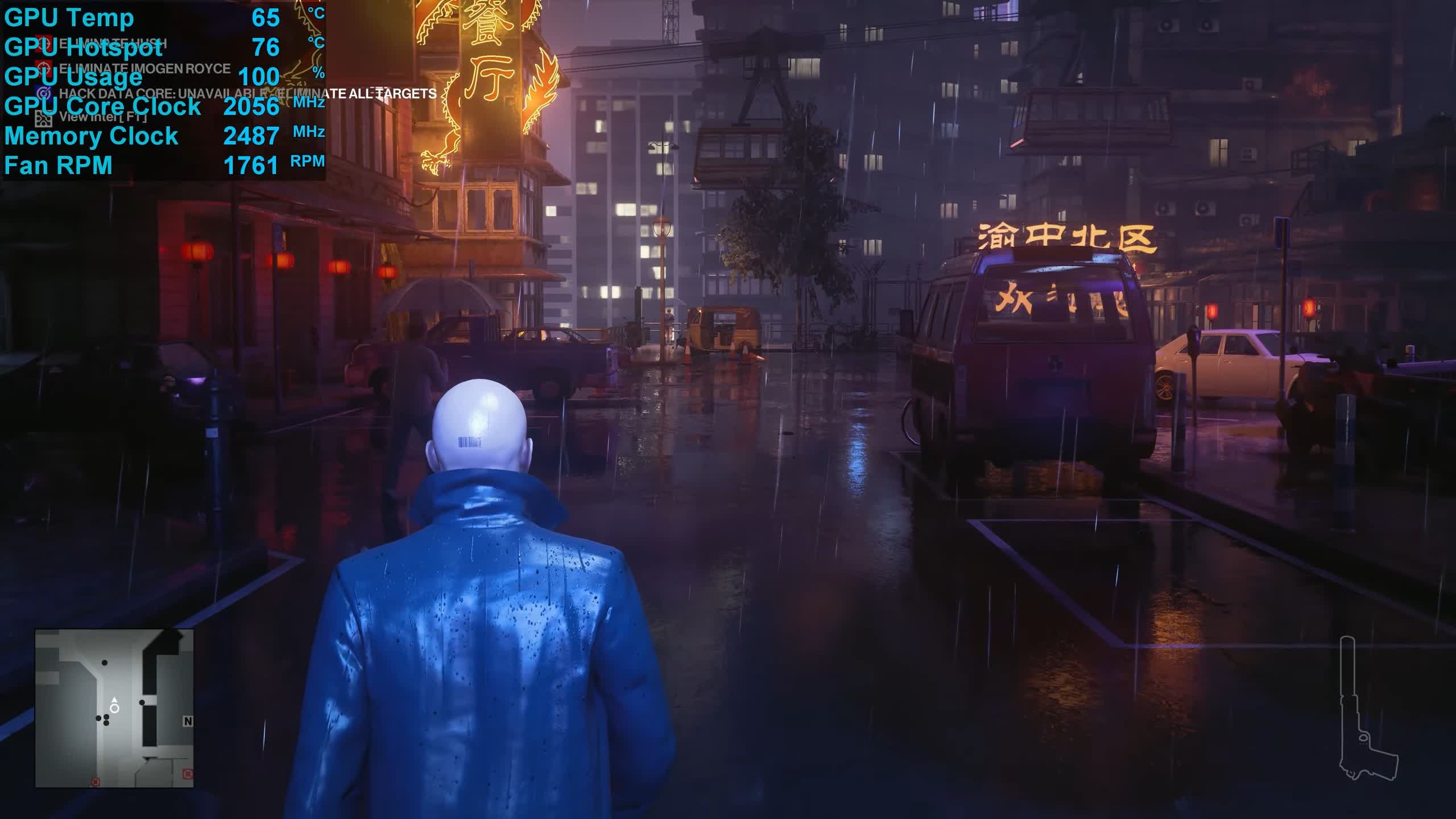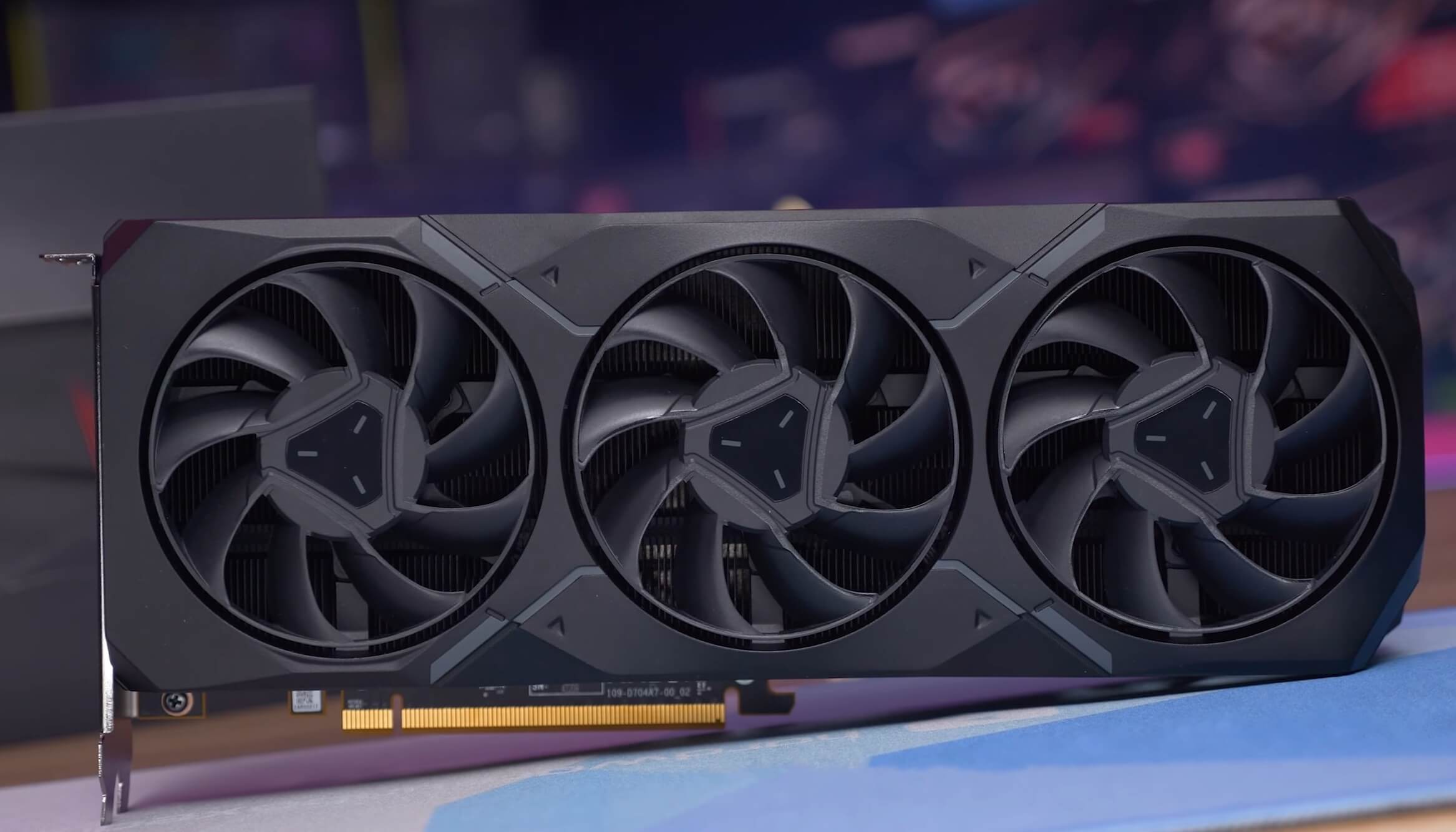The Radeon RX 7900 XT is the second RDNA 3 GPU released thus far, and no, you didn't just read this review days ago, this is the XT version, not the XTX. It's not a good naming convention from AMD, with enough numbers available they surely could have avoided having two products with almost identical names.
The 7900 XT is essentially a cut down version of the 7900 XTX. Instead of 48 workgroup processors we get 42, for a total of 84 compute units -- still an increase on the top RDNA2 model -- this leads to 10,752 shader units. Clock speeds are also a little lower, at a game clock of 2 GHz with a total board power rating of 300W.
Bus width is cut to 320 bit, but we get a healthy 20 GB of it. In terms of core and memory configuration the 7900 XT ends up roughly 85% that of the flagship model, a much smaller gap than Nvidia offers between the RTX 4090 and RTX 4080, the latter of which is like a 60 to 70 percent version of the flagship.
| Radeon RX 7900 XTX | Radeon RX 7900 XT | Radeon RX 6950 XT | Radeon RX 6900 XT | |
|---|---|---|---|---|
| Price (MSRP) | $1,000 | $900 | $1,100 | $1,000 |
| Release Date | Dec 13, 2022 | May 10, 2022 | Dec 8, 2020 | |
| Process | N5 (GCD) / N6 (MCD) | TSMC N7 | ||
| Transistors (billion) | 57.7 | 26.8 | ||
| Chiplets | 1 × GCD / 6 × MCD | 1 × GCD / 5 × MCD | N/A | |
| Die Size (mm2) | 300 mm2 GCD / 37 mm2 MCDs | 520 mm2 | ||
| Core Config | 6144 / 384 / 192 | 5376 / 336 / 192 | 5120 / 320 / 128 | |
| GPU Boost Clock | 2500 MHz | 2400 MHz | 2310 MHz | 2250 MHz |
| Memory Capacity | 24 GB | 20 GB | 16 GB | |
| Memory Speed | 20 Gbps | 18 Gbps | 16 Gbps | |
| Memory Type | GDDR6 | |||
| Bus Type / Bandwidth | 384-bit / 960 GB/s | 320-bit / 800 GB/s | 256-bit / 576 GB/s | 256-bit / 512 GB/s |
| Total Board Power | 355W | 300W | 335W | 300W |
However, considering we weren't blown away by the 7900 XTX, is there any hope for the XT which is selling for just $100 less? Not really. For a 10% saving, the memory capacity, cache and bandwidth have all been reduced by 17%, and surprise, surprise it's 17% slower at 4K, so the cost per frame is actually worse.
The Radeon RX 7900 XT is a product AMD doesn't really want to sell, considering they suggested that they won't have that many defective 300 mm2 GCD. As noted in the 7900 XTX review, the XT version uses the same die, but with one less MCD, 5 rather than 6. This means any GCD that can't be sold as an XTX gets binned as an XT model.
In reality, the 7900 XT is going to be a model that moves in low volumes and this could be due to the fact that AMD has little defective silicon that they need to flog off. But if that isn't the case, you can expect the 7900 XT to drop in price sooner than expected which could actually benefit its prospects.
For testing all GPUs we have used the official clock specifications with no factory overclocking. The CPU used is the Ryzen 7 5800X3D with 32GB of dual-rank, dual-channel DDR4-3200 CL14 memory on the MSI MPG X570S Carbon Max Wi-Fi motherboard. In total we tested 16 games at 1440p and 4K.
Benchmarks
Starting with The Callisto Protocol, we see that at 1440p the 7900 XT is 11% slower than the XTX and just 5% slower than the RTX 4080. It's also 35% faster than the 6900 XT, a 2 year old GPU that launched at $1,000.
The 4K margins are much the same, the 7900 XT was 14% slower than the XTX, though this time 11% slower than the RTX 4080. The margin over the 6900 XT also shrank to 28%.
Next up we have Forza Horizon 5 where the 7900 XT was just 9% slower than the XTX. We still suspect there is some driver related issue in this game as RDNA 3 performance in general is weak relative to what we see in other titles. For example, the 7900 XT was a mere 5% faster than the 6900 XT and slower than the 6950 XT which is unusual.
The 4K results are mildly improved, here the Radeon 7900 XT was 12% slower than the XTX, and rather than trail the 6950 XT, it's 2% faster, so yay.
Moving on to Rainbow Six Extraction, we see that the 7900 XT is good for 238 fps on average, making it 15% slower than the 7900 XTX and 17% slower than the RTX 4080, while it was 28% faster than the old 6900 XT.
Then at 4K, the frame rate drops to 119 fps, making the 7900 XT 17% slower than the XTX version and 25% slower than the RTX 4080. It was also just 5% faster than the RTX 3090, but 35% faster than the 6900 XT.
The Hunt: Showdown performance overall is very impressive with over 200 fps, but relative to competing parts, and previous generation GPUs, it's nothing special.
We're looking at a 18% deficit to the 7900 XTX, while it was 22% faster than the 6900 XT, the 2 year old GPU it's effectively replacing. Well, the XTX does that, but with pricing so similar you could say they both do.
At 4K the 7900 XT fell well behind the XTX, tailing it by a 20% margin, allowing it to only roughly match the RTX 3090, while it was just 15% faster than the 6900 XT, so overall quite a disappointing result.
Like all Radeon GPUs, the 7900 XT does its best work in Call of Duty, pumping out 269 fps in Modern Warfare II. That made it 14% slower than the 7900 XTX, but an impressive 23% faster than the RTX 4080 and 40% faster than the 6900 XT. A great result, though as we found in the XTX review, these results are outliers.
Even at 4K the 7900 XT was impressive with 163 fps on average, making it 16% slower than the XTX model, but 14% faster than the RTX 4080. It was also 35% faster than the 6900 XT, which is a decent generational improvement.
The F1 22 results look disappointing as this game enables ray tracing by default when using the Ultra High quality preset, and while RDNA 3 has made great strides in this regard, it's still at least a generation behind Nvidia when it comes to RT performance.
As a result, the 7900 XT was only able to match the 3080 Ti and 3090, making it 11% slower than the 3090 Ti and 15% slower than the 7900 XTX.
Even at 4K the margins are similar, with the 7900 XT basically able to match the 3080 Ti and 3090, making it 13% slower than the 3090 Ti. A very disappointing result that's a result of having RT effects enabled.
The Cyberpunk 2077 results are far more impressive when we don't have RT effects enabled, we're only using the high quality preset. As a result the 7900 XT was good for 118 fps on average making it just 13% slower than the XTX and a mere 8% slower than the RTX 4080.
Then at 4K we're looking at roughly 60 fps without the aid of upscaling, so that's pretty good. The 7900 XT was 16% slower than the XTX though, so given it's only 10% cheaper that's not great. But when compared to the old 6900 XT we are looking at a 31% performance uplift.
As we found in the Radeon 7900 XTX review, these new RDNA 3 GPUs don't perform particularly well in Dying Light 2, especially relative to previous-gen parts.
The 7900 XT was just 8% faster than the 6900 XT at 1440p in this game at 1440p.
Things are worse at 4K, where the 7900 XT was 6% faster than the 6900 XT, matching the 3090 Ti with 66 fps, though it was just 15% slower than the RTX 4080, so when compared to current generation parts the results do look a lot better.
The last game we're going to look individually is Halo Infinite, before taking a look at the 16 game average data. At 1440p, the Radeon 7900 XT matched the GeForce 3090 Ti making it just 12% faster than the 6900 XT.
Then at 4K we're looking at 82 fps on average, which meant the 7900 XT was 15% slower than the 7900 XTX and 20% slower than the RTX 4080.
16 Game Average
Here's a look at the 16 game average data at 1440p, previously we found the 7900 XTX and RTX 4080 to be neck and neck, the 7900 XT though is 13% slower on average, which isn't amazing given it's only 10% cheaper. It's also just 9% faster than previous generation flagship parts, which seems good for $900, but given today's prices it's not amazing.
The 4K data is even worse as all other system limitations are basically removed, giving the high-end GPUs a bit more breathing room. As a result the 7900 XT is now on average 17% slower than the XTX version.
When compared to sensible previous generation options such as the 6800 XT it was 34% faster and while that might sound like a lot, remember the 6800 XT was released 2 years ago at $650, making the 7900 XT MSRP 38% higher, and worse the 6800 XT has been selling below MSRP for most of the year.
For those of you interested here's the 1080p data, basically if you're playing at lower resolutions or with lower quality settings these new high-end GPUs aren't great in terms of value as frame rate performance is almost always CPU limited.
Ray Tracing + Upscaling Performance
There are no surprises for ray tracing performance as the 7900 XT scales as expected relative to the XTX model. Whereas the Radeon 7900 XT was 15% slower in F1 22 using the ultra high preset which does enable RT effects, using FSR to upscale saw a very similar 14% margin between the XT and XTX.
The Watch Dogs: Legion results are also as expected, with RT disabled we are CPU limited at 1440p, so the XT was just 4% slower than the XTX, but with RT enabled it was 13% slower, which is what we typically see.
Marvel's Guardians of the Galaxy saw the 7900 XT trail the XTX by an 11% margin with ray tracing enabled plus upscaling, and then 13% at the native resolution with ray tracing enabled. So 84 fps on average made it 25% faster than the 6950 XT, but 24% slower than the 3090 Ti.
Here we see when using FSR 2 with ray tracing enabled the 7900 XT was 18% slower than the XTX and then 15% slower with upscaling disabled. So again these are the margins you'd expect to see given the specifications.
Finally, Cyberpunk 2077 ray racing performance at 1440p using the ultra effects the 7900 XT was good for just 35 fps on average or 59 fps with FSR enabled, making it 13% slower than the XTX model and a massive 29% slower than the RTX 3090 Ti.
Power Consumption
On paper the 7900 XT is meant to consume 55 watts less than the XTX and we're seeing numbers that are pretty close to that mark in our total system testing.
In short, the Radeon 7900 XT lowered total system usage by 48 to 53 watts in our testing when compared to the XTX model. That's around a 9-12% reduction in total system usage for 13-17% less performance. Of course, if we were to just look at GPU power usage it would be more like a 15% reduction, but still nothing amazing.
With the frame rate locked at 90 fps in Cyberpunk 2077 we see that the 7900 XT drops total system consumption by 4% when compared to the XTX model, so there is some power saving to be had with few active cores and one less MCD, even at the same performance target.
Cost per Frame
Although the flagship Radeon 7900 XTX does represent the best cost per frame ratio of any GPU released in the last two years, the marginally more affordable 7900 XT doesn't.
We're looking at a rather large 8% increase in cost per frame for the XT, making it in terms of value inferior to a number of previous generation high-end products, such as the 6800 XT.
It's also only a 13% discount from the RTX 4080, which isn't enough given how much more well rounded the GeForce GPU is. But of course, the real issue for the 7900 XT is the XTX, at just $100 more there is simply no reason to purchase this. In our opinion, you'd buy the 7900 XTX every time.
The 7900 XT is less impressive when looking at current market prices, too, basically slotting in alongside the 6900 XT and 6950 XT in terms of value, costing a little more for a little more performance, so RDNA 3 is hardly retiring RDNA 2. There's no need to draw a comparison with competing Nvidia products as the 7900 XT makes no sense at $900 when you can buy the 7900 XTX for $1,000.
Cooling
Here's a quick look at thermal and clock behavior of the AMD reference model. Installed inside an ATX case in a 21c room the Radeon RX 7900 XT peaked at a hot spot temperature of 77c after an hour of gameplay with a peak average die temperature of 65c, and this was achieved with a fan speed of 1750 RPM.
The typical operating clock frequency was 2055 MHz and the memory operated at 19.9 Gbps, just shy of the advertised 20 Gbps. Overall the reference card ran cool and relatively quiet.
What We Learned
In our opinion, there's no reason to buy the Radeon RX 7900 XT, you'd always just spend $100 extra to get the faster 7900 XTX. For the XT model to make sense it needs to cost $200 less than the XTX, anything short of that and you might as well buy the fully fledged model.
Short of a GeForce competitor like the RTX 4070 that could shake things up (doubtfully from a pricing perspective), the new Radeon 7900 XT would have been something we could recommend at $800.
It's a somewhat weird situation where the $900 option is not great value that you are better off spending $1,000, but if you're going to spend such a massive sum of money, you might as well dig deep for another $200 and get the RTX 4080 for that DLSS support, NVENC, and superior ray tracing performance.
With the GeForce RTX 4080 at $1,200 (which we don't recommend you to buy), the Radeon 7900 XTX would be far more attractive at around $900, and the XT version selling for no more than $750.
The only advantage of the Radeon 7900 XT over a part like the RTX 4080 is the VRAM capacity, though the 16GB of the GeForce GPU is more than enough and we suspect will be for some time to come, but of course, this will matter more for comparison with lower-end Ada Lovelace GPUs that are yet to be released.
Pricing this generation is by far a bigger issue than memory capacity, so while it's great that the 7900 XT packs 20 GB of VRAM, it doesn't get it across the line.
